Plastic Surgery
Plastic Surgery In Korea
The perfect nose is different for each person. There are measurements and statistics which can help create an ideal treatment plan but your own subjective view must be taken into consideration as well.
Seoul Guide Medical ensures that you get the nose which you want, based on your needs. Your nose is 1/3 of your face and nose must be made to proportionally fit your facial features. In general, the ideal nose length is 1/3 of your face with the angle between your nose bridge and tip at 45°. The angle between the forehead and nose bridge should be 135°-140° for women and 135° for men. The angle between the nose and upper lip should be 90°-100° for women (please note that on some women the angle of 95°-105° will look better) and 90° for men (please note that on some men a slightly higher angle will look better).
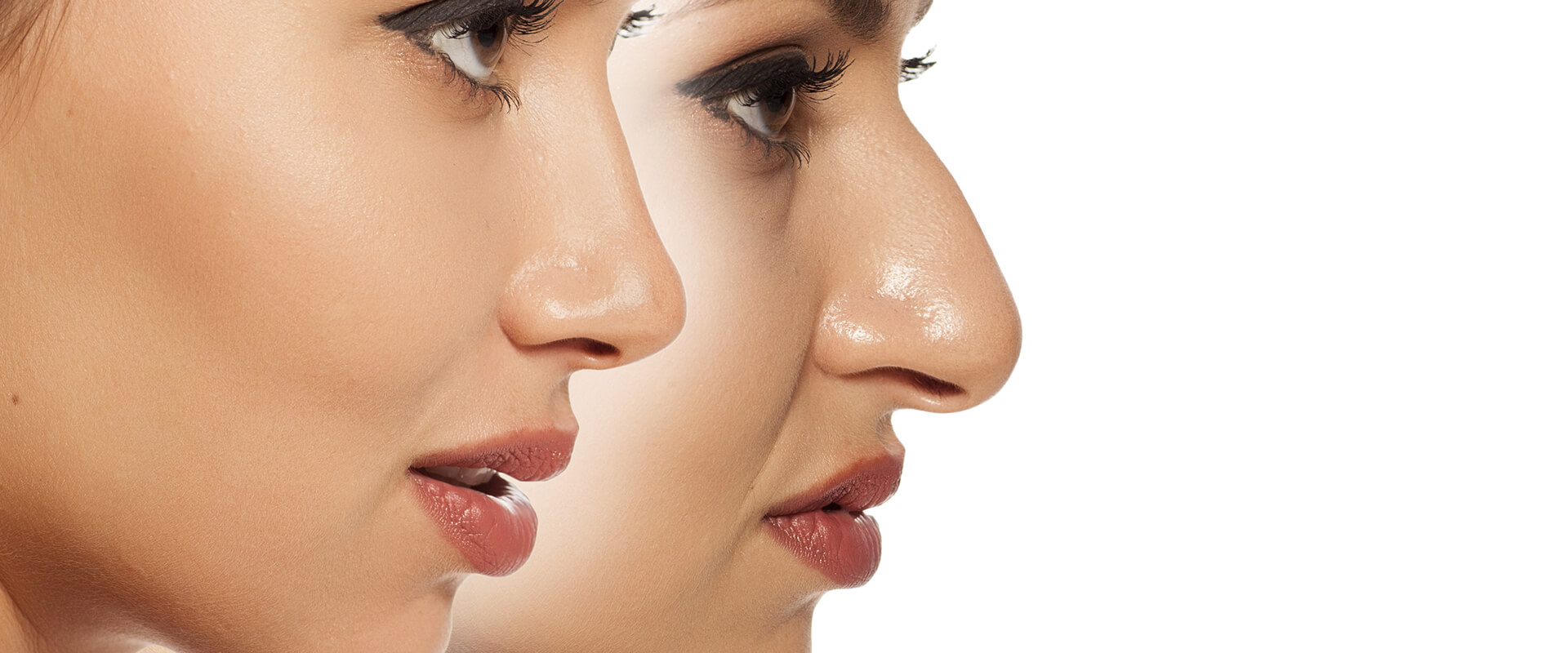
1. It is important to stop taking all unnecessary medications and vitamins including such things as: birth control pills, hormone drugs, vitamin supplements, aspirin etc for 2 weeks prior to surgery if possible. Any substance which can increase bleeding should be discontinued from ingestion. If you are undergoing treatment for diabetes, thyroid issues, heart disease and hypertension, please let our consultants know immediately.
2. The healthier you are before surgery, the faster you will recover. It is important to stop smoking cigarettes and drinking alcohol for at least 3 days before surgery. Eating whole foods like vegetables and fruits will improve your after surgery recovery as well.
3. On the surgery day, you should wear comfortable loose fitting clothes (zip ups are great), remove jewellery, remove make-up, remove nail polish and take out your contact lenses.
4. In most cases for Rhinoplasty, it will be done under local anesthesia with sedation and so you must fast (no drinking liquids or eating foods) for 4-6 hours depending on your consultation. In some cases, 8 hours of fasting will be recommended (usually in general anesthesia cases).
1. Our helper and translator will be with you every step of the way including after your surgery when you wake up. We will be there to nurse you with love and care while helping you to recover in the clinic. We will provide pumpkin porridge and pumpkin juice for your recovery as these increase your recovery rate (please let us know if you do not like pumpkin or have an allergy), analyze your recovery, help you get your after treatment package and medication.
2. Swelling goes up for 2-3 days before it starts to come down so it is important to use the ice packs we give you as much as possible. The more you ice, the faster you will recover. Swelling is not even on all sides so one side may swell more than the other. Swelling around the eyes may happen as well for some people. Some people experience bruising under the eyes as well which can last for 2-3 weeks.
3. Take all medication until completion, come back for your scheduled check-ups and cleanings and try to sleep on your back.
4. Smoking and drinking after surgery for at least 4 weeks is highly discouraged as it will affect your recovery and possibly your results.
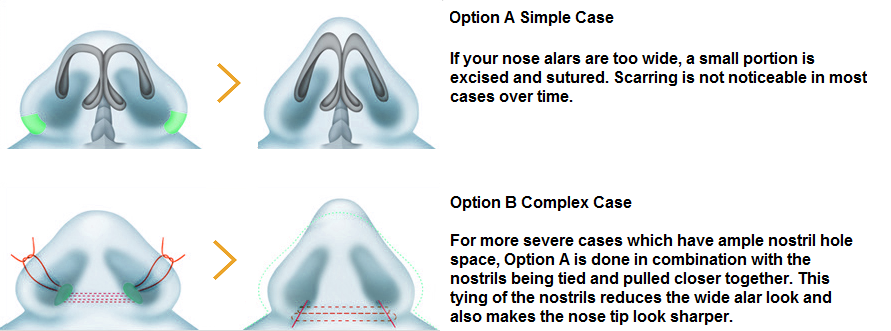
This procedure is recommended for those who appear to have wide nostrils, flat nostrils, arrowhead-like nose, and those who are unhappy with the current nose shape. If you are having tip plasty, then the nostrils will naturally come in a bit and alar reduction surgery may not be needed.
For cases which need alar reduction, please note that there is a limit to how narrow the nostril can be shaped. It is important to follow the doctor’s advice when it comes to the width of your nostrils. Simple cases require a small portion of the alar to be excised and sutured.
Complex cases require the excision of some alar material and the tying of the nostrils to be done in order to bring them closer together. Scarring from the incisions is barely visible on people with darker skin tones and virtually invisible on people with lighter skin tones.
Surgery Time: 1.5-2 hours
Anesthesia: Local with sedation (deep sleep)
Hospitalization: You can leave the clinic after 2-3 hours
After Surgery Check-ups: 3
Recommended Minimum Time in Seoul: 7 days (5 days if stitches are removed in your home country)
Recovery Time to Normal Look: 2-4 weeks
Recovery Time to Full Setting: 6-12 months
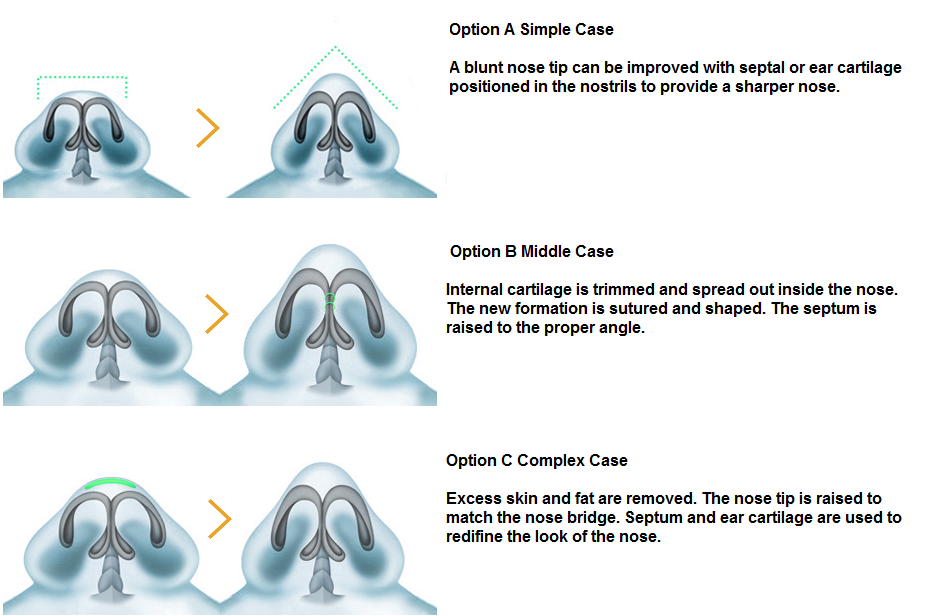
Blunt nose tips are very common and happen when the nostrils are too wide, the cartilage on the nose tip is too spread out and when there is too much fat and skin tissue on the tip of the nose.
By refining the nose tip, you can improve your overall look to bring your nose into balance with the rest of your face. Simple cases require septal or ear cartilage to be used to shape the nose tip. More complicated cases additionally require the trimming of cartilage and possible tying to create the desired shape. The most complex of cases requires the removal of excess skin and fat as well.
Surgery Time: 1.5 hours
Anesthesia: Local with sedation (deep sleep)
Hospitalization: You can leave the clinic after 2-3 hours
After Surgery Check-ups: 3
Recommended Minimum Time in Seoul: 7 days (5 days if stitches are removed in your home country)
Recovery Time to Normal Look: 2-4 weeks
Recovery Time to Full Setting: 6-12 months
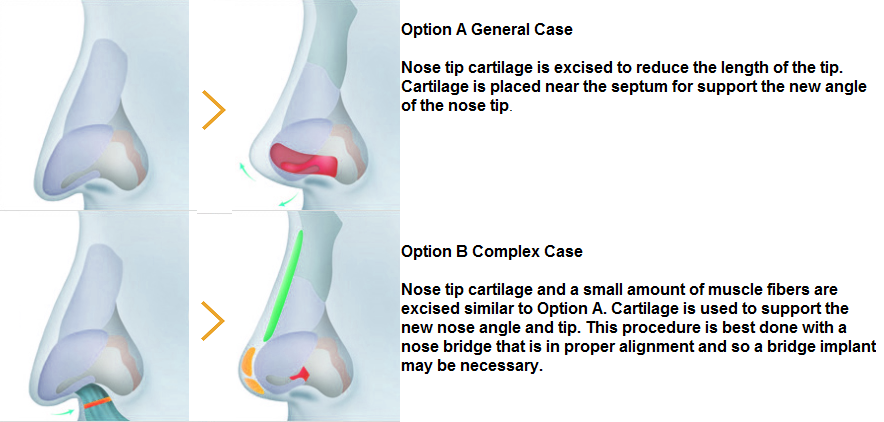
If your nose tip is dropping or pointed down like an arrow, this procedure is right for you. This is sometimes referred to as a “ptotic” nose. The nasal tip is too long and drops down causing facial imbalance.
This procedure is very complex and only a rhinoplasty specialist should do it. Seoul Guide Medical can help you find the right specialist for you. Some of your nose tip cartilage is excised to reduce the tip length. Cartilage is positioned on the nose tip near the septum to raise it and set the correct angle. In complex cases, additional cartilage is used on the nose tip and near the septum along with a possible bridge implant.
Surgery Time: 1.5-2 hours
Anesthesia: Local with sedation (deep sleep)
Hospitalization: You can leave the clinic after 2-3 hours
After Surgery Check-ups: 3
Recommended Minimum Time in Seoul: 7 days (5 days if stitches are removed in your home country)
Recovery Time to Normal Look: 2-4 weeks
Recovery Time to Full Setting: 6-12 months
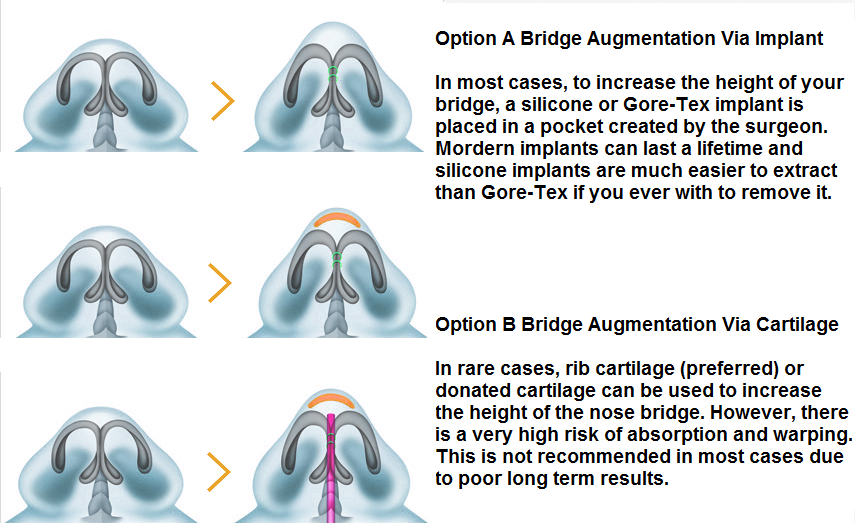
Tip plasty is done to reduce the width of the nose slightly, to refine the nose tip and to give the nose tip a sharper point. There are several methods which vary depending on the severity of the case. For simple cases, the nose tip is adjusted via tying. For more difficult cases, the nose tip is tied internally and cartilage is grafted to the nose tip. This cartilage can come from the septum or the ear if needed. For complex cases, a strut has to be created from cartilage to support the tip.
Surgery Time: 30 minutes-1 hour
Anesthesia: Local with sedation (deep sleep)
Hospitalization: You can leave the clinic after 2-3 hours
After Surgery Check-ups: 3
Recommended Minimum Time in Seoul: 7 days (5 days if stitches are removed in your home country)
Recovery Time to Normal Look: 2-4 weeks
Recovery Time to Full Setting: 6-12 months
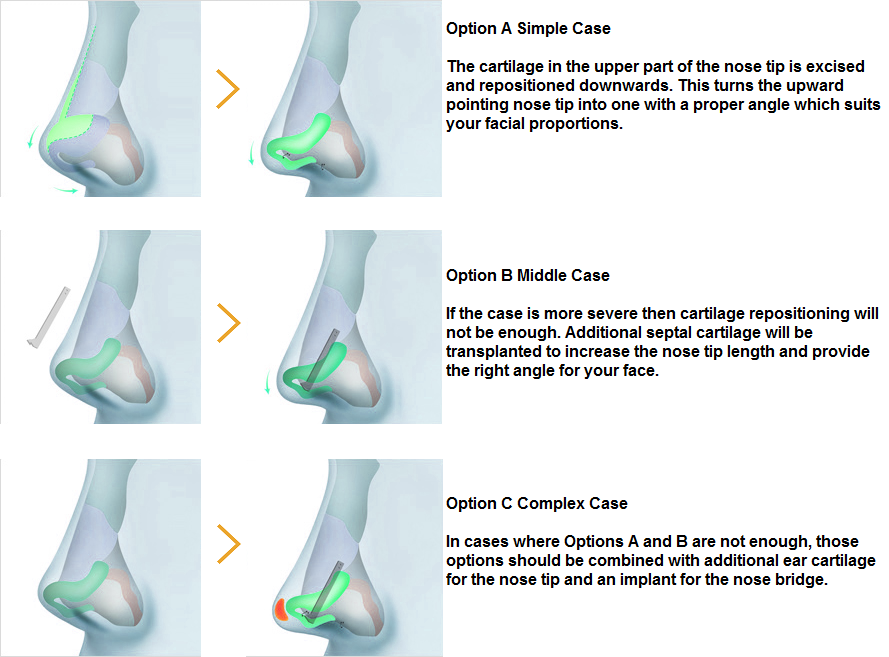
A short and upturned nose is complicated to correct and must be done by a rhinoplasty specialist. In simple cases, cartilage is excised from the upper part of the nose tip and the nose is adjusted to the correct angle. More difficult cases require additional septal cartilage to be grafted to reach the correct angle. In complex cases, additional ear cartilage will be used to prop up the nose tip.
Surgery Time: 30 minutes-2 hour
Anesthesia: Local with sedation (deep sleep)
Hospitalization: You can leave the clinic after 2-3 hours
After Surgery Check-ups: 3
Recommended Minimum Time in Seoul: 7 days (5 days if stitches are removed in your home country)
Recovery Time to Normal Look: 2-4 weeks
Recovery Time to Full Setting: 6-12 months
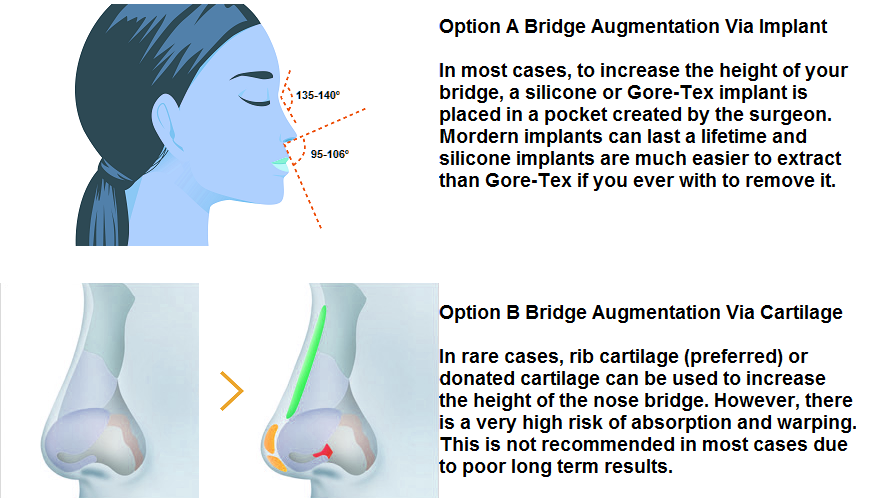
When the nose bridge is not high enough, a nose bridge implant can be placed. This is often known as dorsal augmentation. It enlarges and straightens the nose bridge to proper proportions. The best types of implants to use are silicone and Gore-Tex. Please note that silicone is easier to remove if you ever need to and so it is recommended in most cases.
Gore-Tex is extremely hard to remove and thus has more risk associated with it but it is always on a cases by cases basis. In some cases, cartilage from the rib or donated cartilage can be used to augment the nose bridge. However, this is not appropriate in most cases as the cartilage tends to warp and absorb into the body. This means that initially, the results are just as good as the bridge implant but in the long run revision may be necessary due to warping and absorption.
Surgery Time: 30 minutes-1 hour
Anesthesia: Local with sedation (deep sleep)
Hospitalization: You can leave the clinic after 2-3 hours
After Surgery Check-ups: 3
Recommended Minimum Time in Seoul: 7 days (5 days if stitches are removed in your home country)
Recovery Time to Normal Look: 2-4 weeks
Recovery Time to Full Setting: 6-12 months
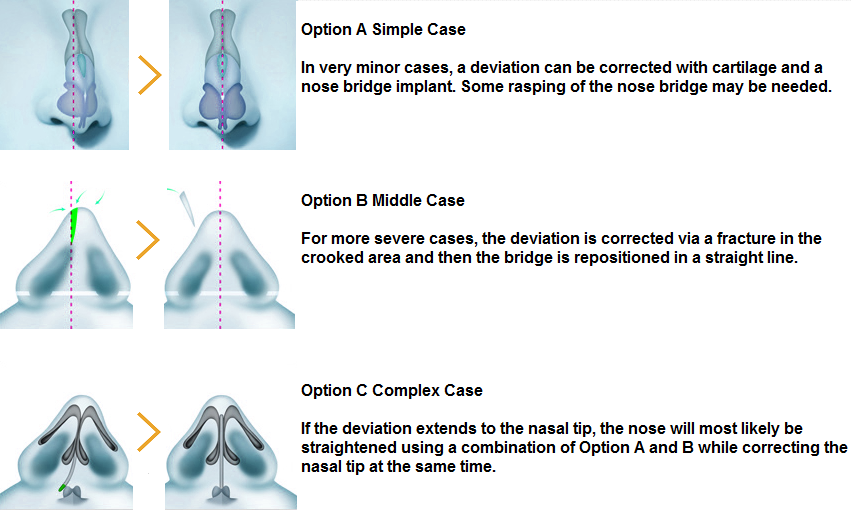
If your nose is crooked, it can cause internal breathing issues, nasal congestion, headaches and other issues. Septoplasty is often performed to correct the nose internally. For more complicated cases, a slight fracture is created and the crooked area removed. Complex cases may require the tip to be straightened the same time. This also helps to improve the shape of the nostril holes.
Please note that although ENTs are good at what they do, a plastic surgery will provide a much better outcome for a beautiful, straight nose. We have seen hundreds of cases where a crooked nose was corrected at a general hospital through an ENT and the aesthetic results were unsatisfactory. Thus, our plastic surgeons redid the work in a more aesthetic manner.
Surgery Time: 1.5-2.5 hours
Anesthesia: Local with sedation (deep sleep)
Hospitalization: You can leave the clinic after 2-3 hours
After Surgery Check-ups: 3
Recommended Minimum Time in Seoul: 7 days (5 days if stitches are removed in your home country)
Recovery Time to Normal Look: 2-4 weeks
Recovery Time to Full Setting: 6-12 months

Bumps or humps in the nose can cause you look more severe and really throw your face out of balance. To correct a humped nose, an incision is made on the inside of the nose and the hump is shaved or rasped. More difficult procedures require the nose hump to be fractured and cartilage to be used to prevent drooping in the tip of the nose.
Many hump removal cases require the tip to be corrected as well. Sometimes, the hump takes up much more space on the nose bridge than it appears to from the outside. Removing it will cause the nose to look extremely flat so a bridge implant is placed sometimes to provide proper nose bridge height and the tip is corrected to provide the correct angle.
Surgery Time: 1.5-2 hours
Anesthesia: Local with sedation (deep sleep)
Hospitalization: You can leave the clinic after 2-3 hours
After Surgery Check-ups: 3
Recommended Minimum Time in Seoul: 7 days (5 days if stitches are removed in your home country)
Recovery Time to Normal Look: 2-4 weeks
Recovery Time to Full Setting: 6-12 months
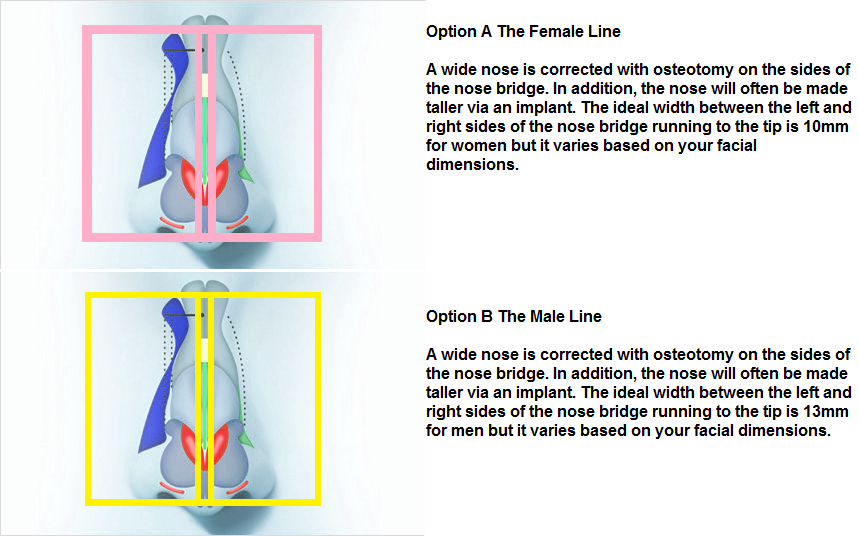
If you have a wide nose bridge then the sides of the nose bridge can be reduced via an osteotomy to provide a more refined look. This procedure narrows the nose bridge and if needed, an implant can be placed on the nose bridge for added height. The female line have a 10mm nose width between the left and right sides of the nose bridge running to the tip of the nose. The male line should have a width of 13 mm. However, some cases require different widths according to the look you want to have. Seoul Guide Medical is here to make sure your desires are taken into consideration along with the statistics.
Surgery Time: 1.5-2 hours
Anesthesia: Local with sedation (deep sleep)
Hospitalization: You can leave the clinic after 2-3 hours
After Surgery Check-ups: 3
Recommended Minimum Time in Seoul: 7 days (5 days if stitches are removed in your home country)
Recovery Time to Normal Look: 2-4 weeks
Recovery Time to Full Setting: 6-12 months
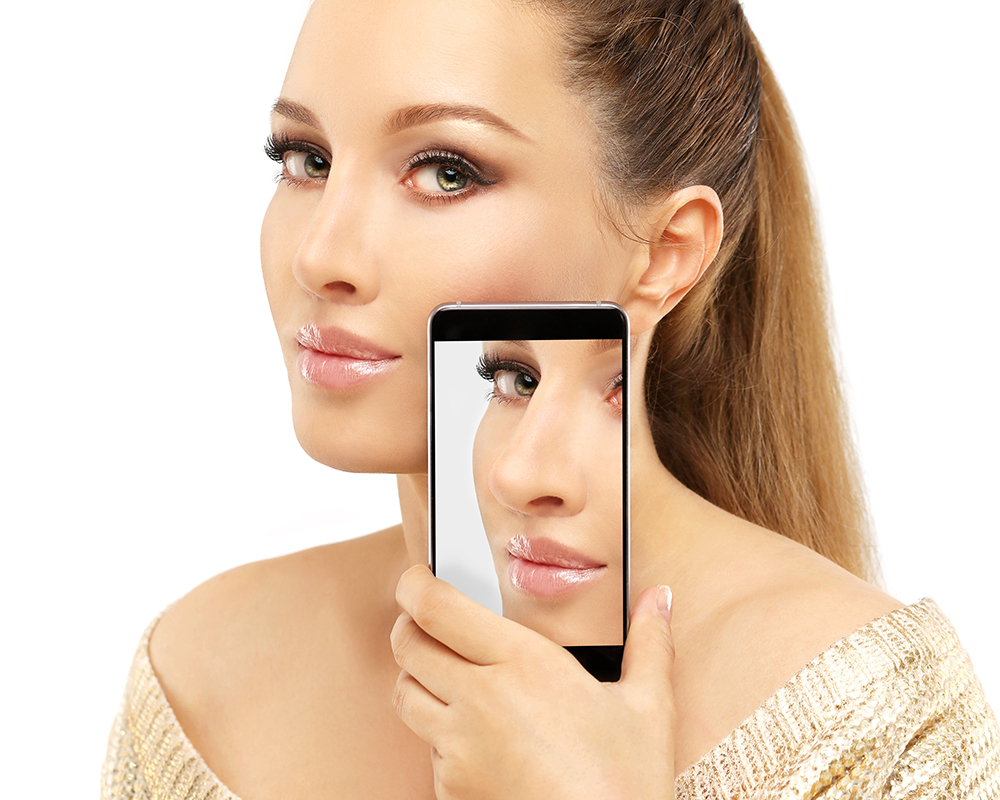
Revision rhinoplasty is much harder to perform than a first time surgery. You can expect the surgery time to be longer and the cost to be much higher. This is why it is so important to choose the correct doctor the first time. Seoul Guide Medical knows all the best doctors in Korea, their training, habits and most importantly their results.
We can help determine which rhinoplasty specialist is best for your revision rhinoplasty procedure in Korea. We have analyzed thousands of rhinoplasty revision cases done through us and through our network of clinics and the results show that 59% of these cases were originally done by an inexperienced surgeon in Korea(not through Seoul Guide Medical) with insufficient Rhinoplasty training.
General plastic surgeons are good at many different procedures but what you want is a plastic surgeon that is the best in Rhinoplasty. Often these cases come from locations with low demand for plastic surgery and thus the doctors can’t specialize in a certain area or from locations where they compete based solely on price (super low cost countries). 32% of these revision cases experienced problems due to doctors which take too many cases per day (factory-like hospitals and clinic). This is simply human error due to fatigue and stress. You want a doctor who is fresh and healthy, not one who is tired from doing too many surgeries per day.
Only 9% of the revision cases examined occurred due to unexpected and unforeseen complications. The results show that choosing the right doctor, the first time, is extremely important. This is why we are here. Seoul Guide Medical will get you the Rhinoplasty specialist who is right for you.
Surgery Time: 3-4.5 hours
Anesthesia: Local with sedation (deep sleep)
Hospitalization: You can leave the clinic after 2-3 hours
After Surgery Check-ups: 3
Recommended Minimum Time in Seoul: 7 days
Recovery Time to Normal Look: 3-5 weeks
Recovery Time to Full Setting: 9-12 months
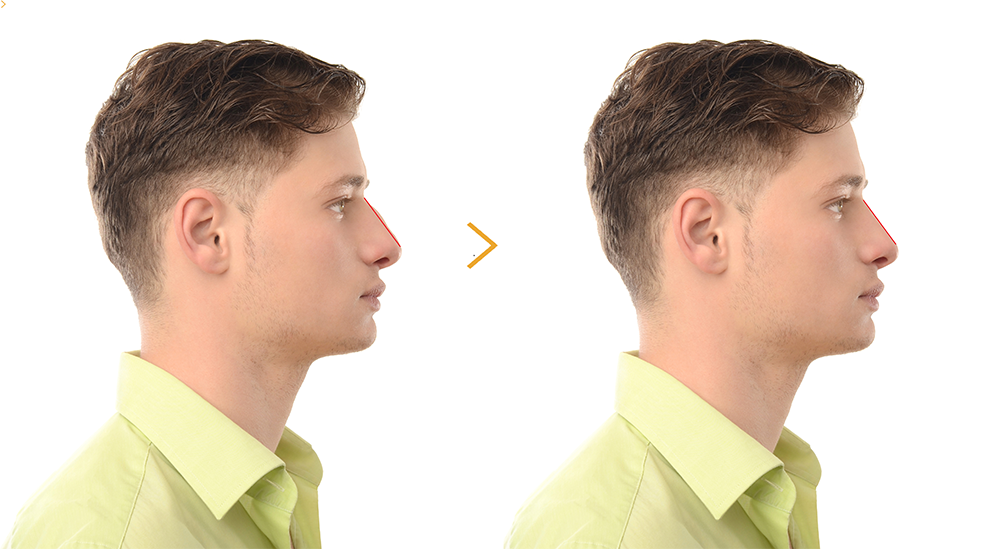
Male Rhinoplasty is now common in Korea and the results are impressive. The ideal nose bridge width is usually 13mm with the nose projecting out 130° between the forehead and nose. The angle between the nose and lip should be 90°. Each case is different and your needs and wants will be considered. While feminine noses have a slight curve to them, male noses are often straight giving a more powerful and masculine appearance. This procedure is often combined with a scarless chin implant for those who have a receding chin look. Our founder himself went through a male rhinoplasty and we are experts in this field. Let Seoul Guide Medical get you the look you want.
Surgery Time: 1.5-3.5 hours
Anesthesia: Local with sedation (deep sleep)
Hospitalization: You can leave the clinic after 2-3 hours
After Surgery Check-ups: 3
Recommended Minimum Time in Seoul: 7 days
Recovery Time to Normal Look: 2-3 weeks
Recovery Time to Full Setting: 6-9 months
The eyes are very important to the overall balance of your face and can greatly impact how people perceive you. Although there is a subjective portion to eye beauty, in general, the width of each eye should be between 30mm-34mm for most people.
The inner corners of the eyes should line up in a perpendicular line to the nose alars while the outer corner of the eyes should make a straight diagonal line to the nose alars. The angle of the eyes leading from the inner to outer corner should have a slight elevation going from the inner to the outer corner.
People with bigger eyes (meaning that more of the iris and the white area of the eyes can be seen) are considered, in general, more beautiful and so procedures such as ptosis correction and double eyelid surgery are popular to achieve this effect. The upper and lower eyes should have smoother skin without bags or drooping skin in order to provide a younger and healthier look. If the doctor recommends it, then a combination of procedures will produce better effects.

If you have a single eyelid which is are making your eyes look smaller than they are, the most effective and permanent solution is incisional double eyelid surgery. This procedure can consist of the full incisional method or the partial incisional method. A delicate horizontal incision is made across the eyelid and excess fat is removed from the eyelid.
This procedure is best done on people who have thicker eyelids and or have fat deposits in their eyelids. This procedure is very safe and ranks as even safer than non-incisional methods
Surgery Time: 30-45 minutes
Anesthesia: Twilight anesthesia
Hospitalization: You can leave the clinic after 1 hour
After Surgery Check-ups: 2
Recommended Minimum Time in Seoul: 7 days (5 days if stitches are removed in your home country)
Recovery Time to Normal Look: 2-3 weeks
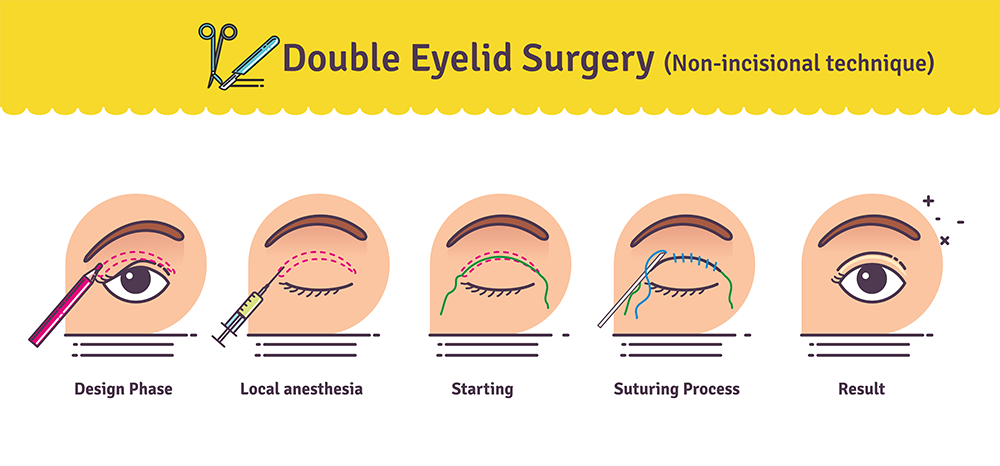
If you possess a single eyelid formation which is not too thick or droopy then the non-incisional method may work for you. This method creates a double eyelid by making delicate sutures along the eyelid without the need for an incision. Please note that we refer to this method as semi-permanent. There is a high probability that over time the sutures will fail and you will need to undergo this treatment again or have the incisional method anyways. If you are looking for the best long term results then the incisional method is best for most cases.
Surgery Time: 30 minutes
Anesthesia: Twilight anesthesia
Hospitalization: You can leave the clinic after 1 hour
After Surgery Check-ups: 3
Recommended Minimum Time in Seoul: 5 days preferred but 3 days minimum
Recovery Time to Normal Look: 1-2 weeks
Recovery Time to Full Setting: 6-9 months
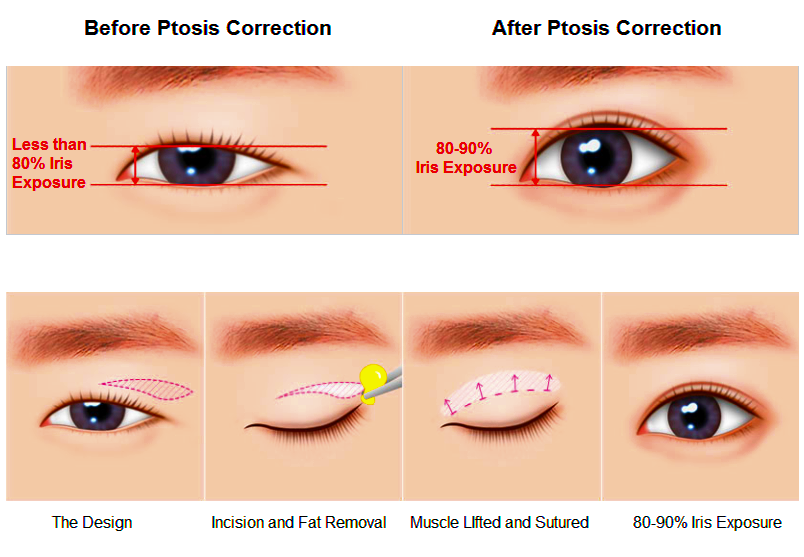
If you have a piece of skin called the Mongolian fold covering the inner corner of your eye, epicanthoplasty is a great option to make your eyes larger. This skin flap can make the distance between your eyes too spread out and causes your eyes to appear small. By repositioning the Mongolian fold, a softer and gentler look can be achieved and balance can be brought to your face. This procedure is often done in combination with ptosis correction, double eyelid surgery and or lateral canthoplasty.
Surgery Time: 30 minutes
Anesthesia: Twilight anesthesia
Hospitalization: You can leave the clinic after 1 hour
After Surgery Check-ups: 2
Recommended Minimum Time in Seoul: 5-7 days
Recovery Time to Normal Look: 1-2 weeks
Recovery Time to Full Setting: 6-9 months
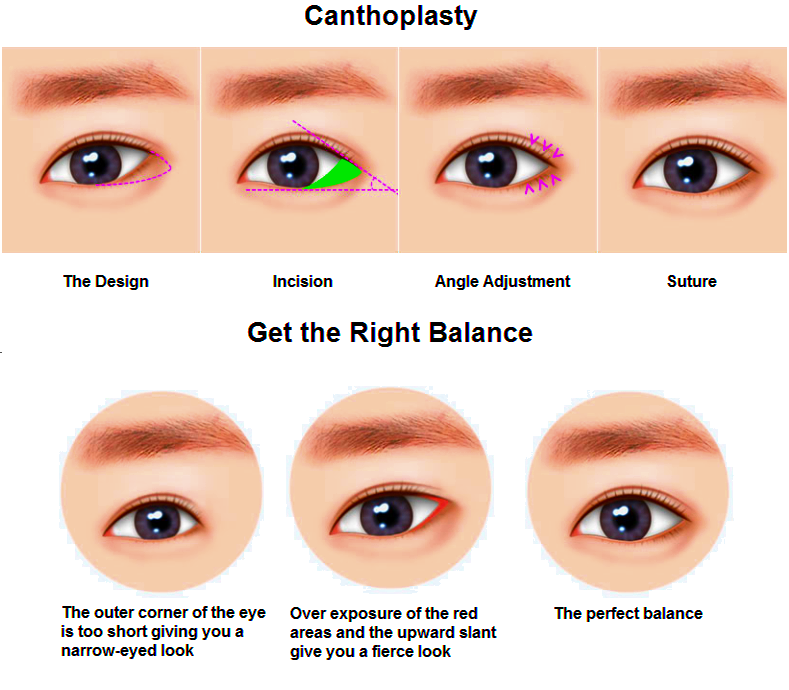
When the outer corner of the eye is too short, it makes your eyes look narrow and small. Lateral canthoplasty corrects slanted eyes and increases the amount of white that can be seen in the outer eye corner. This procedure makes your eyes look more gentle, bigger and brighter. It is often combined with ptosis correction, double eyelid surgery and or epicanthoplasty.
Surgery Time: 30 minutes
Anesthesia: Twilight anesthesia
Hospitalization: You can leave the clinic after 1 hour
After Surgery Check-ups: 2
Recommended Minimum Time in Seoul: 7 days (5 days if stitches are removed in your home country)
Recovery Time to Normal Look: 1-2 weeks
Recovery Time to Full Setting: 6-9 months
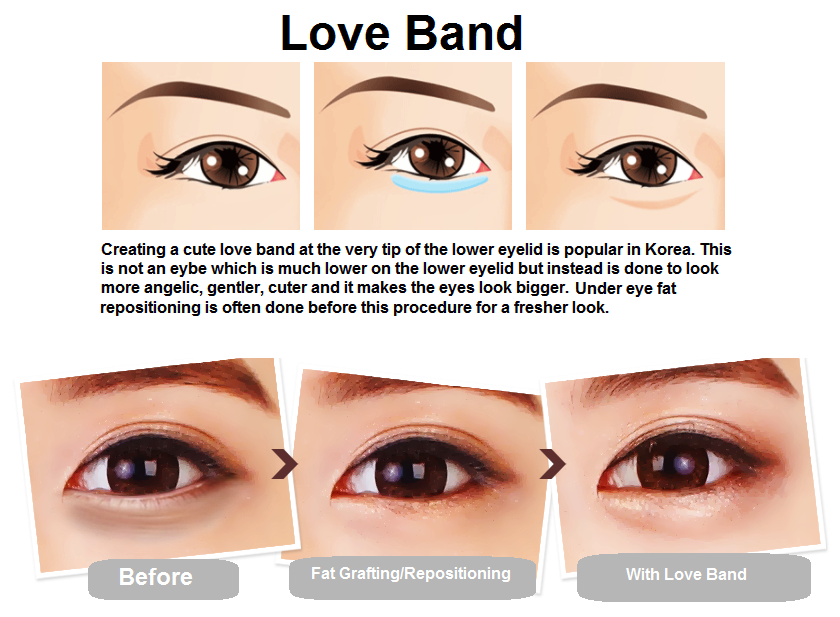
The Korean Love Band is a popular procedure where either filler or fat is injection through the tear duct in the upper part of the lower eyelid. It provides a younger, cuter look which is softer and more feminine. The most popular method is via filler and it can last up to 6 months in this area. It is recommended you go with dissolving filler and not the semi-permanent kind in this area. Fat grafting can also be done but we recommend filler instead of fat as you can dissolve filler right away if you don’t like the look. This look is very popular in Korea amongst women ages 20-35.
Anesthesia: Twilight anesthesia if needed
Hospitalization: You can leave the clinic after 30 mins to 1 hour
After Surgery Check-ups: none needed for filler
Recommended Minimum Time in Seoul: 1 day
Recovery Time to Normal Look: 3-4 days
Recovery Time to Full Setting: 1 week

If part of the upper eyelid is drooping down and covering too much of the iris, it will make your eyes look smaller and can even limit your vision. This problem is called ptosis (pronounced ‘tosis’) and happens when you have weakened muscles in the eyelid. This problem can affect your vision and cause you to use your forehead muscles to compensate which creates more lines and wrinkles in your forehead. In most case, an incision will be made and excess tissue and fat will be removed. The muscles are then tightened and the area is sutured. Because an incision is most often required, the double eyelid line can be made at this point if requested.
Normally, the double eyelid is reformed in a better way or created newly with ptosis correction. This is the most complex procedure surrounding the eyes and should be done by a specialist.
Surgery Time: 1 hour
Anesthesia: Twilight anesthesia
Hospitalization: You can leave the clinic after 1- 1.5 hours
After Surgery Check-ups: 2
Recommended Minimum Time in Seoul: 5-7 days
Recovery Time to Normal Look: 3-4 weeks
Recovery Time to Full Setting: 6-9 months
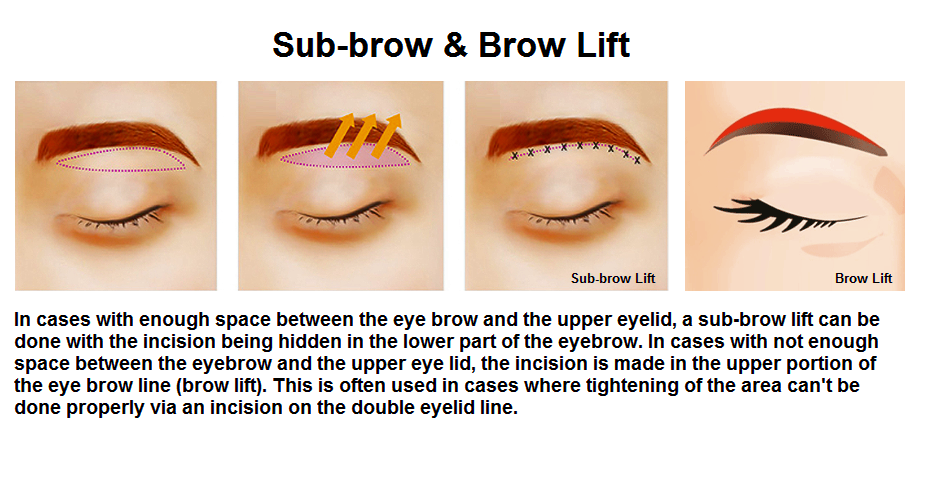
The forehead and upper eye area can be tightened if needed with either a sub-brow or a brow lift. Normally, upper blepharoplasty can create a similar effect but for people with thicker skin, these may be a better option. In a sub-brow lift, the incision is made below the eyebrow, excess skin is removed, the skin is pulled and tightened. In a brow lift, the incision is made above the eyebrow, excess skin is removed, and the skin is pulled and tightened.
What is right for you depends if there is enough space between your upper eyelid and your eyebrow for a sub-brow lift. If there is not enough space between the sub-brow area and the eye then a brow lift will better suit your needs.
Surgery Time: 1 hour
Anesthesia: Twilight anesthesia
Hospitalization: You can leave the clinic after 1- 1.5 hours
After Surgery Check-ups: 2
Recommended Minimum Time in Seoul: 7 days (5 days if you remove stitches in your home country)
Recovery Time to Normal Look: 3-4 weeks
Recovery Time to Full Setting: 6-9 months

If you have too much excess skin on your lower eyelid it can lead to lower eyelid drooping. Lower blepharoplasty is done to remove this excess of skin and is often combined with under eye fat repositioning and under eye fat grafting to leave the under eye looking younger and smoother. Stitching is done along the top of the lower eyelid which means the scarring is virtually invisible or invisible over time.
Surgery Time: 1 hour
Anesthesia: Twilight anesthesia
Hospitalization: You can leave the clinic after 1- 1.5 hours
After Surgery Check-ups: 2
Recommended Minimum Time in Seoul: 7 days (5 days if you remove stitches in your home country)
Recovery Time to Normal Look: 3-4 weeks
Recovery Time to Full Setting: 6-9 months
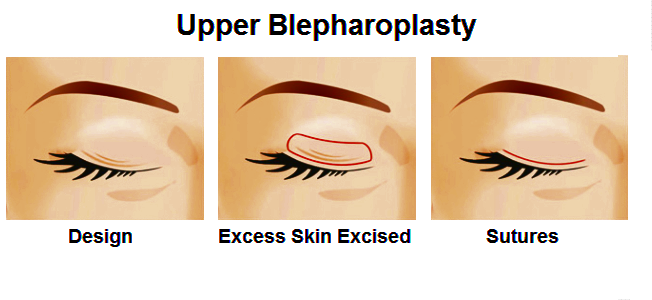
If the skin on your upper eyelid is droopy or saggy, the excess skin can be excised, tightened and sutured to create a younger look. Fat may be removed if it is having a negative impact on the upper eyelid. Without this kind of procedure, the forehead is forced to work harder to open the eyes. This causes more lines and wrinkles in the forehead. In addition, the excess skin can cause vision impairment leading to a limited field of vision. This procedure will help to decrease wrinkles and lines in the forehead and improve your vision as well as make you look younger.
Surgery Time: 1 hour
Anesthesia: Twilight anesthesia
Hospitalization: You can leave the clinic after 1- 1.5 hours
After Surgery Check-ups: 2
Recommended Minimum Time in Seoul: 7 days (5 days if you remove stitches in your home country)
Recovery Time to Normal Look: 3-4 weeks
Recovery Time to Full Setting: 6-9 months
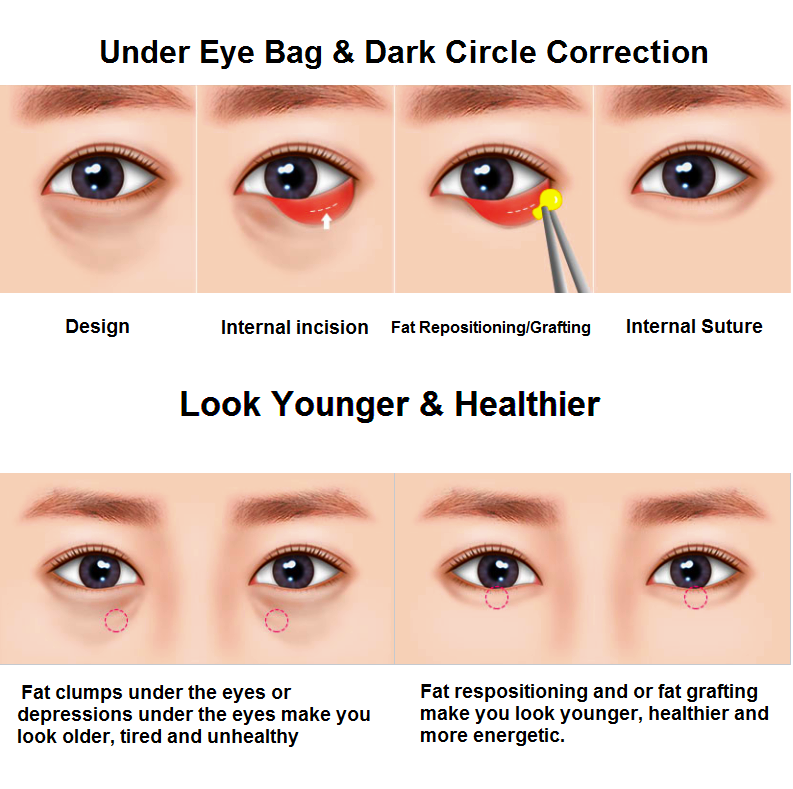
As we age, fat clumps under our eyes and creates bags. In some people, fat can dissipate and create depressions which leads to dark circles. This causes us to look older, more tired and appear unhealthy. Under-eye fat repositioning releases the clumped fat through an internal incision and then spreads out that fat to create a younger, healthier and more vibrant look. Under eye fat grafting takes your fat from either your tummy through the belly button or from the back of the thigh. The fat is processed and grafted it into depressed areas.
Please note that in most cases, doctors prefer to use back of the thigh fat as it tends to last longer and be more effective than belly fat when being repositioned under the eye. This procedure can be done alone or in combination are among the most effective anti-aging procedures with results immediately seen after the removal of the taping (usually after 5 days). There is no external incision or stitch. It is all done on the inside of the lower eyelid.
Surgery Time: 30 mins
Anesthesia: Twilight anesthesia
Hospitalization: You can leave the clinic after 1 hours
After Surgery Check-ups: 2
Recommended Minimum Time in Seoul: 5 days
Recovery Time to Normal Look: 1-2 weeks
Recovery Time to Full Setting: 4-6 months
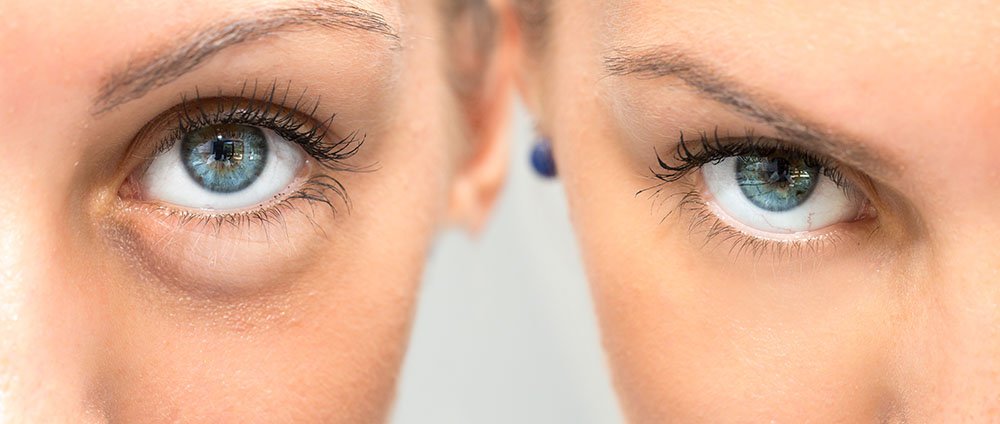
It is important to choose the best doctor for your eye procedure the first time. Revision cases are always more complex and more expensive than first time procedures. If you do need a revision procedure.please take note that your recovery time will be longer. This doesn’t mean you require more time in Korea, but it does mean that your swelling and bruising (if any) will last longer. It is more important than ever to ice as much as possible after a revision procedure. Ice is your friend. Seoul Guide Medical is here to make sure you get the proper plastic surgery procedure done right, the first time. However, if you need revision then trust the experts. Trust in SGM.
Surgery Time: 1-2.5 hours
Anesthesia: Twilight anesthesia
Hospitalization: You can leave the clinic after 1.5- 2 hours
After Surgery Check-ups: 2-3
Recommended Minimum Time in Seoul: 7 days
Recovery Time to Normal Look: 3-5 weeks
Recovery Time to Full Setting: 6-12 months
Jaw & Face Plastic Surgery in Korea
If you would like to improve the shape and balance of your facial features then there are many face contouring procedures. Key points like the nose and eyes are not included when speaking about face contouring. Instead, we are talking about the cheeks, jaw, chin, forehead and the overall shape of the face.
The most common procedures for face contouring are: zygoma reduction (cheekbone reduction), mandible reduction (square jaw reduction) and chin alternation (genioplasty, implant or shaving). Fat grafting (fat addition) is another great option to add to areas which are depressed such as the mouth lines, under the eyes, and forehead to create a smoother and younger look. Procedures such as the V-line procedure(s) which can improve the cheek, jaw and chin have longer recovery times.
Seoul Guide Medical is here to help you get the correct treatment, the best doctor and the best service. Contact us now and get a personalized and free consultation.
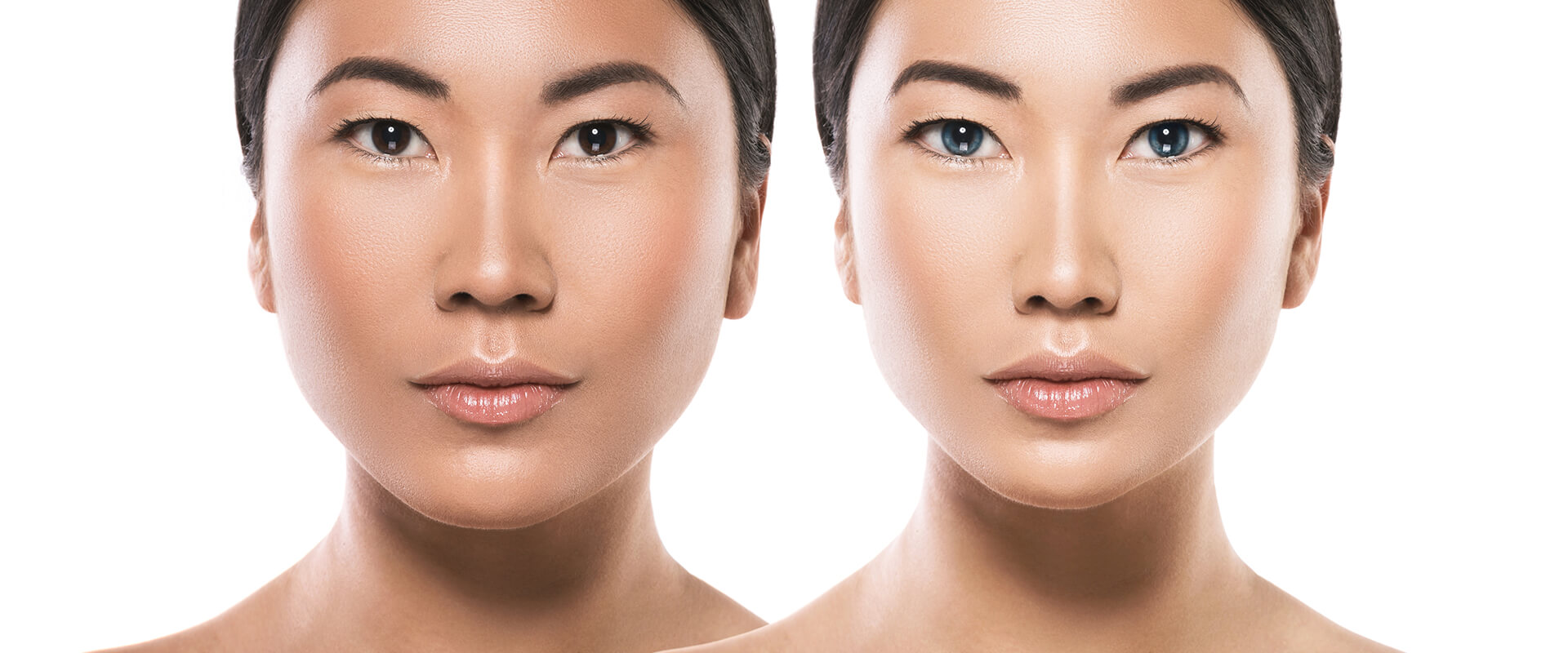
Everyone has slight asymmetry between the left and right sides of their faces. However, too much asymmetry is considered unattractive. You can self-diagnose for asymmetry if you look for slanted lips, jaw, eye line, the center line of your front teeth and mouth. Often imbalance in the face is from birth but it can also be caused by physical impact, chewing habits (chewing with only one side of the mouth) and damaged teeth. Seoul Guide Medical can analyze your face and we can consult you on whether or not you qualify for asymmetrical face correction surgery. To correct this issue, square jaw reduction or genio- osteotomy is done where part of the jaw and or chin is shaved and removed to achieve balance. For severe cases, Two Jaw Surgery is performed working on the upper and lower jaw and remove jaw bone where needed. Two Jaw Surgery can only be done by a specialist and not all people qualify for it. Contact SGM now to see if you qualify.
Surgery Time: 2-3 hours
Anesthesia: General Anesthesia
Hospitalization: 1-2 days
After Surgery Check-ups: 5
Recommended Minimum Time in Seoul: 14 days
Recovery Time to Normal Look: 4 weeks
Recovery Time to Full Setting: 6-12 months
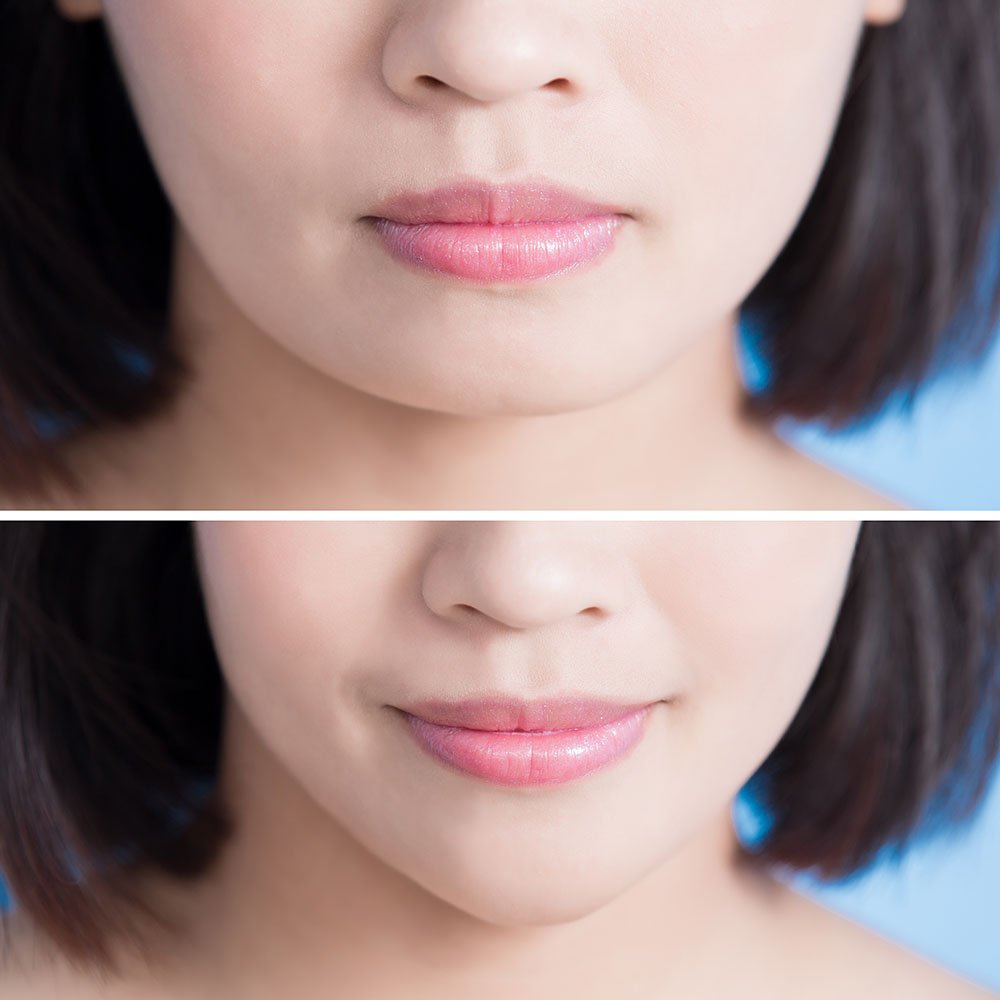
If your forehead is flat or has depressions it can be balanced out with an implant or with fat grafting. Implants are placed through an incision inside the hairline to hide any possible scarring.
Implants lasts for life, are safe and produce the best long term results as they will always maintain their shape. Fat grafting is done when fat is taking from another body part, processed and grafted into the forehead. About 50% of the fat remains after 1-2 months and the amount of fat that survives can be improved if you combine this treatment with stem cell PRP therapy at the same time although not all clinics offer this. The remaining fat is permanent although large reductions in weight also cause a decrease in fat.
Surgery Time: 1-2 hours
Anesthesia: Local with sedation (deep sleep)
Hospitalization: You can leave the clinic after 2-3 hours
After Surgery Check-ups: 3
Recommended Minimum Time in Seoul: 7 days (5 days if stitches are removed in your home country)
Recovery Time to Normal Look: 2-3 weeks
Recovery Time to Full Setting: 6-12 months

If your jaw shape is large and square then a more dynamic V-line shape may be right for you. The goal of this procedure is to create a V-line look going from your jaw to your chin. This process may consist of 1,2 or 3 procedures depending on your case.
For simple cases, only the chin will need to be shaped using chin shaving and or genioplasty. For more complex cases, the jaw bone will need to be shaved as well using mandible reduction surgery to create the look. For the most complex cases, the cheekbones are also reduced using zygoma reduction.
Key points for this look are that the facial width should appear slender and small. The jaw length should be at a ratio of 0.8:1 with .08 being the width of the jaw and 1 being the forehead horizontal length above the eyebrows. The chin should have a shorter and slim look while the nose tip line running down to the lower lip should make the lower lip 2mm lower than the nose tip. Only a specialist should perform these kinds of surgery.
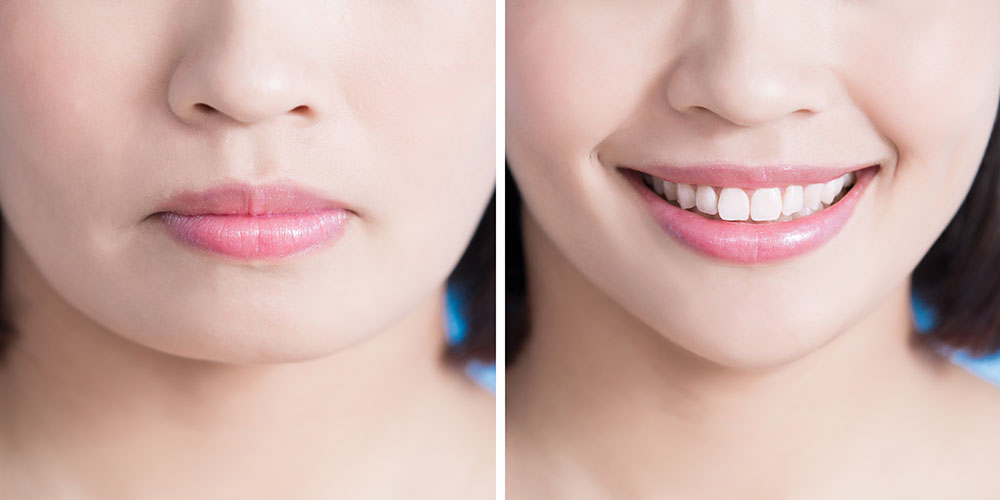
For cases where minor adjustments to the chin are needed, the chin bone can be shaved and shaped to the desired appearance. Often, people have their chins reduced into a more V-line shape which is considered more feminine and beautiful. This procedure is done through the inside of the mouth and no external incision is required.
Surgery Time: 1-2 hours
Anesthesia: Local with sedation (deep sleep)
Hospitalization: You can leave the clinic after 2-3 hours
After Surgery Check-ups: 3
Recommended Minimum Time in Seoul: 7 days (5 days if stitches are removed in your home country)
Recovery Time to Normal Look: 2-3 weeks
Recovery Time to Full Setting: 6-12 months
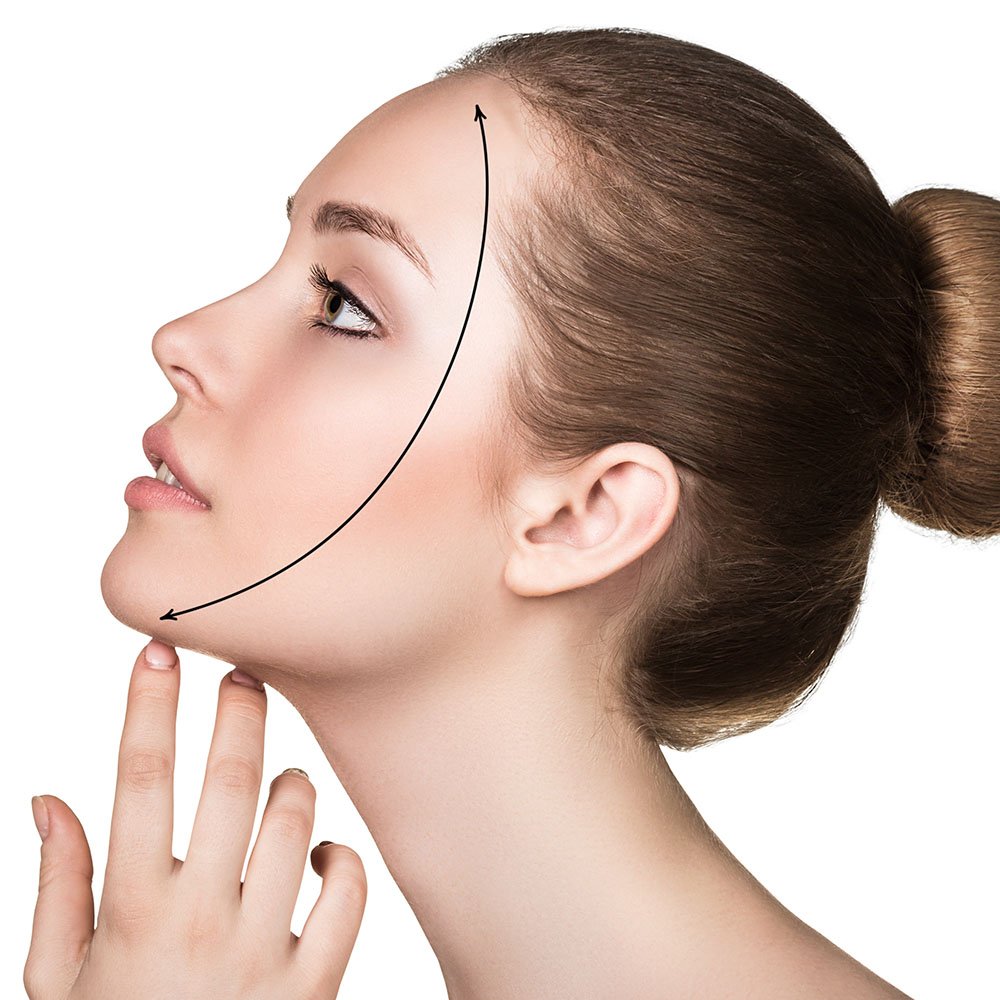
If your chin is not as pronounced then the lower portion of the chin bone can be slid forward giving you a more pronounced chin. This procedure is done through the inside of the mouth and no visible scars are made. This procedure is best for those who need 4mm or more in chin projection and require shaping of the chin such as creating a more V-line look. Because you makes up 1/3 of your facial structure, it is very important to have the chin in proper balance.
Surgery Time: 1.5-2.5 hours
Anesthesia: Local with sedation (deep sleep)/General anesthesia
Hospitalization: You can leave the clinic after 3 hours
After Surgery Check-ups: 3-4
Recommended Minimum Time in Seoul: 7 days
Recovery Time to Normal Look: 2-3 weeks
Recovery Time to Full Setting: 6-12 months

If your chin is recessed and you don’t want an extensive procedure like genioplasty then a chin implant may be right for you. An implant is placed through the inside of the mouth to provide a projection for the chin.
Ideal candidates for implants are those who require an increase of 4mm or less of chin projection. If you are not ready yet for a chin implant then additional dimensions can be added using chin filler although the result won’t be as dynamic as a chin implant. This filler lasts for 6 months to 1 year usually and it can be dissolved via an anti-filler injection if you don’t like the look.
There are 5 and 10-year fillers for the chin out there but not all people qualify for it and it is much harder to remove later on (can only be removed via a surgical procedure).
Surgery Time: 30 minutes-1.5 hours
Anesthesia: Local with sedation (deep sleep)
Hospitalization: You can leave the clinic right away for chin filler and after 1-2 hours for the chin implant
After Surgery Check-ups: 1-3
Recommended Minimum Time in Seoul: 1 day for filler and 7 days for the chin implant
Recovery Time to Normal Look: 1-3 weeks
Recovery Time to Full Setting: 6-12 months
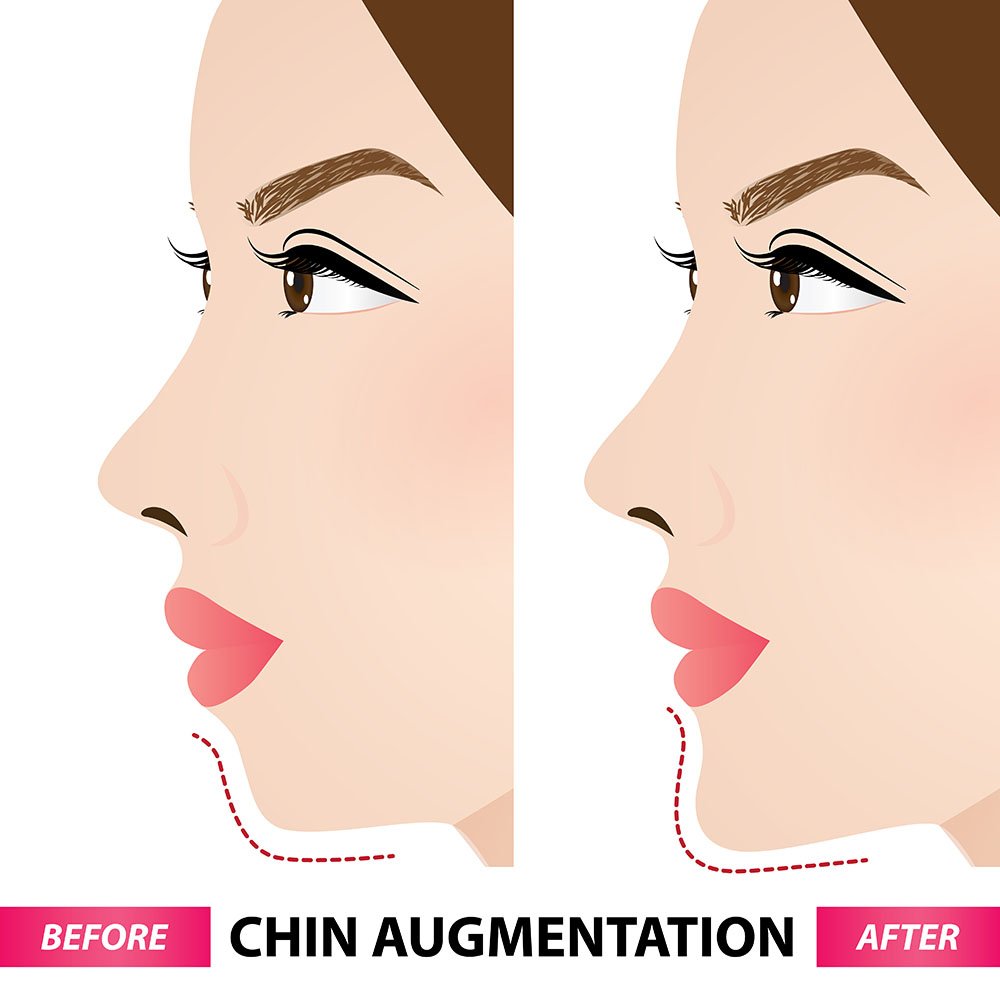
If your chin is protruding outwards, it can give you a long faced look. Typically, a long lower chin is often accompanied by showing too much of the gum line during smiling. The jaw is usually oversized and wide due to over development of the lower jaw. Usually, there is asymmetry in the jaw as well. There are three methods to correct this issue:
Surgery Time: 2-4 hours
Anesthesia: General Anesthesia
Hospitalization: 1-3 days
After Surgery Check-ups: 5
Recommended Minimum Time in Seoul: 14 days
Recovery Time to Normal Look: 4 weeks
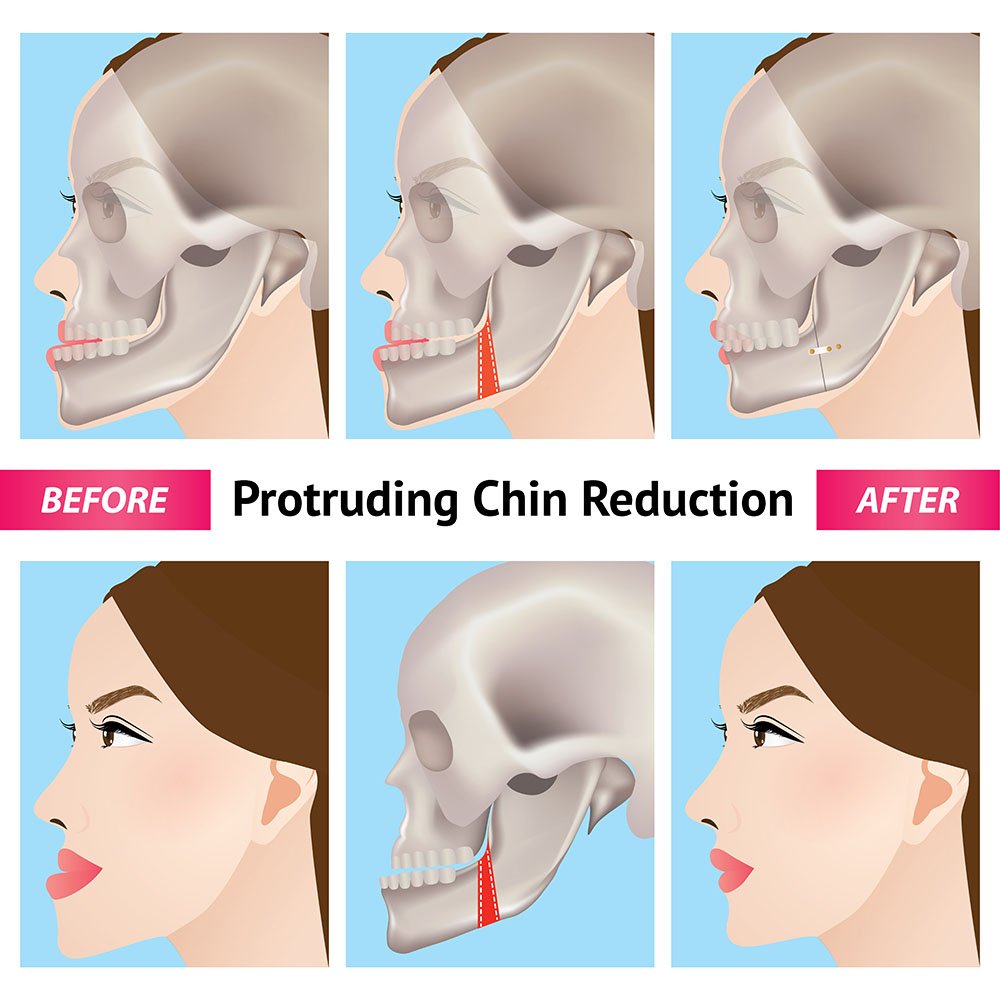
If the cheekbones are too large, wide and prominent then this procedure can improve your facial balance. Zygoma reduction affects the cheekbones by reducing their look via trimming, fracturing and rotating. This procedure often creates a softer and gentler look.
The surgery is done through the inside of the mouth and thus no visible scar is made. This procedure is often combined with square jaw reduction and chin surgery as a part of V-line surgery.
Surgery Time: 2-4 hours
Anesthesia: General Anesthesia
Hospitalization: 0-1 days
After Surgery Check-ups: 5
Recommended Minimum Time in Seoul: 14 days
Recovery Time to Normal Look: 3-4 weeks
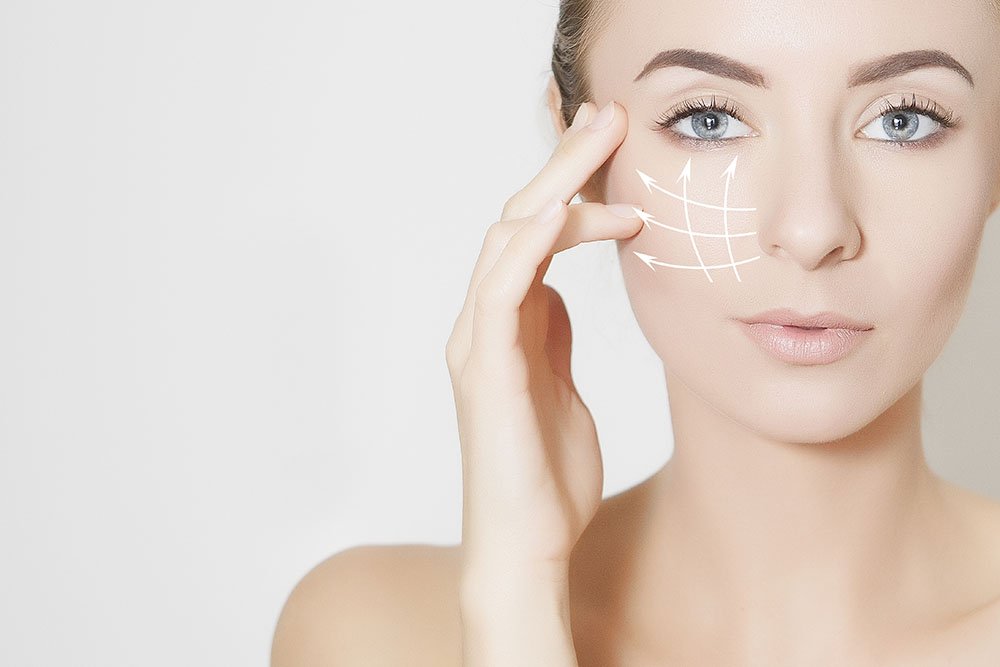
If your jaw is wide and flat then the lower jaw bone can be shaved at an angle to create a more beautiful look often referred to as the V-line look. It is important to go with the look that is best for your facial features. For example, if you only want to do square jaw reduction without zygoma reduction, then the amount of the reduction is limited to the size of your cheekbones. Seoul Guide Medical can provide you with a personalized consultation and let you know exactly which procedures are right for you. This procedure is often combined with zygoma reduction and chin surgery as a part of V-line surgery.
Surgery Time: 2-4 hours
Anesthesia: General Anesthesia
Hospitalization: 0-1 days
After Surgery Check-ups: 5
Recommended Minimum Time in Seoul: 14 days
Recovery Time to Normal Look: 3-4 weeks

Depressed and flat areas on your face can be improved by removing fat from your body, processing it and grafting it into place. The most common areas to transfer fat to are the mouth lines, under the eyes, the cheeks and the forehead. If you want to have a younger and more youthful look then this procedure is for you. About 50% of the grafted fat remains in place permanently after 1-2 months and you can improve the percentage of survival for the fat transfer by performing stem cell PRP therapy at the same time (please note that not all clinics offer this advanced procedure). Typically, surgeons remove a little excess fat and it can be stored in the clinic for 1-2 months. Many clinics offer a free or heavily discounted touch up procedure if you come back within their time frame. Although fat grafting produces the best and most long-lasting results, those who are averse to a surgical procedure can undergo temporary filler injections instead. Please note that filler is best suited for small areas such as under the eyes and the mouth lines. Forehead and cheek filler is often not recommended as the area is too large and the results are mixed at best but it is always on a case by case basis.
Surgery Time: 1 hour
Anesthesia: Local Anesthesia with sedation (deep sleep)
Hospitalization: You may leave the hospital after 1-2 hours
After Surgery Check-ups: 2-3
Recommended Minimum Time in Seoul: 3-7 days
Recovery Time to Normal Look: 3-4 weeks
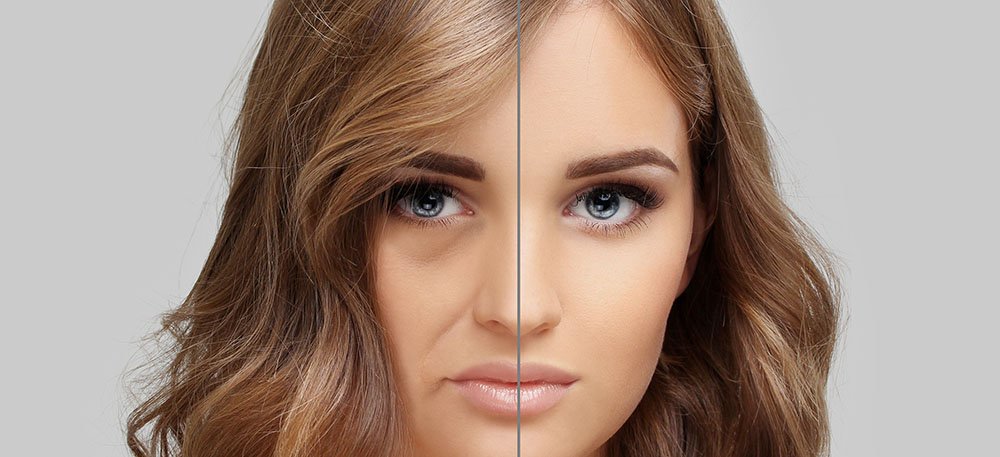
Aging is a normal part of life. How you age is now up to you as we have more control than ever over our looks. By far the most effective anti-aging procedures are surgical procedures such a face lift, neck lift, fat removal, fat addition and excess skin removal. If you don’t qualify just yet for a surgical procedure there are many non-surgical options such as Botox, filler, thread lifting, laser tightening and stem cell therapy. Seoul Guide Medical will help you choose what is right for you.
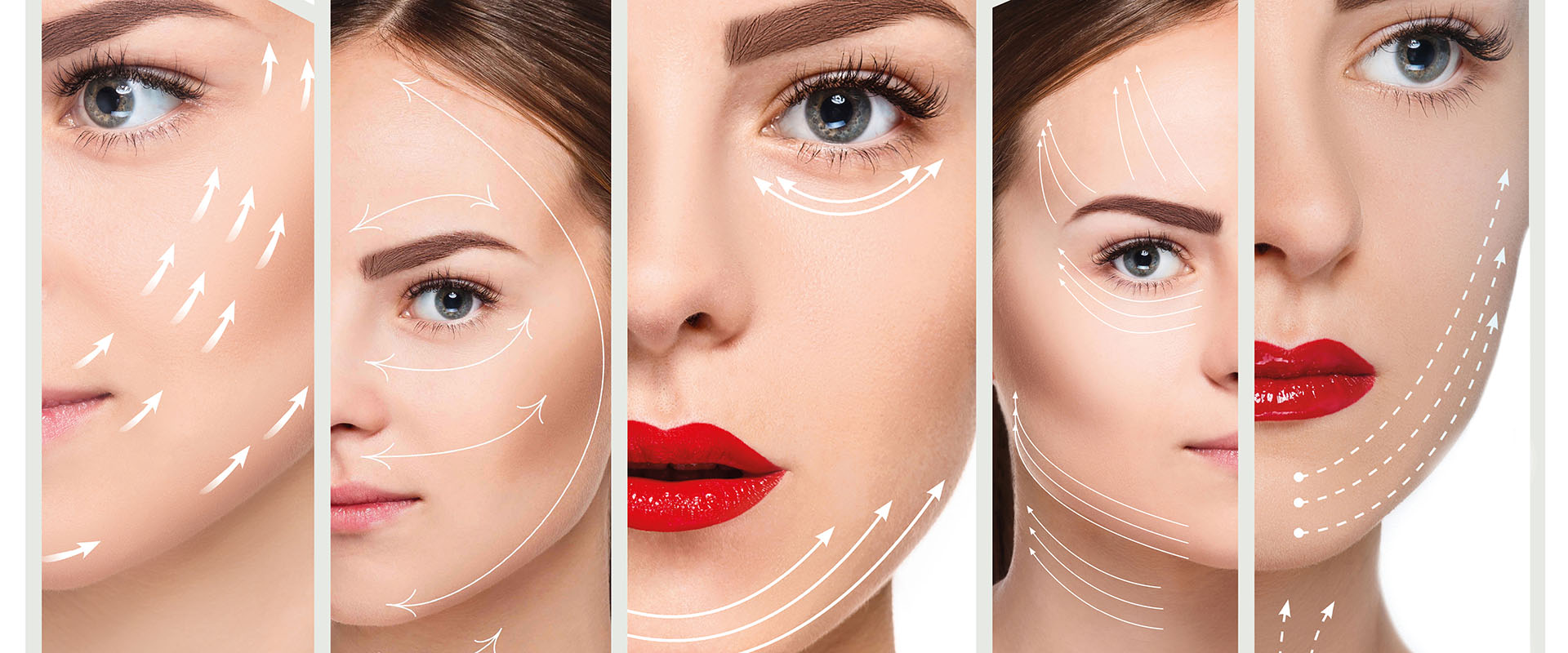
As we age, the skin on our faces starts to droop and sag. If the case is minor, a non-incisional approach would be better via non-surgical thread lifting + lifting laser.
However, in many cases, the excess skin can only be removed via an excision. This is when a surgical facelift is a better option. The surgical facelift removes SMAS tissue within the skin, pulls the skin upwards and creates a tighter face overall. Excess drooping skin is removed and the results is a much younger and healthier appearance with a large reduction in drooping skin, wrinkles and excess skin.
The incision is made around the ear and the way it is done in Korea makes the incision virtually invisible over time. The facelift is a very complex and detailed procedure which requires a specialist. Seoul Guide Medical is here to help you choose the best specialist to suit your needs. Although there are many variations of the facelift, they can be subdivided into the mini-facelift and the full facelift although there are many names that doctors give to these two procedures.
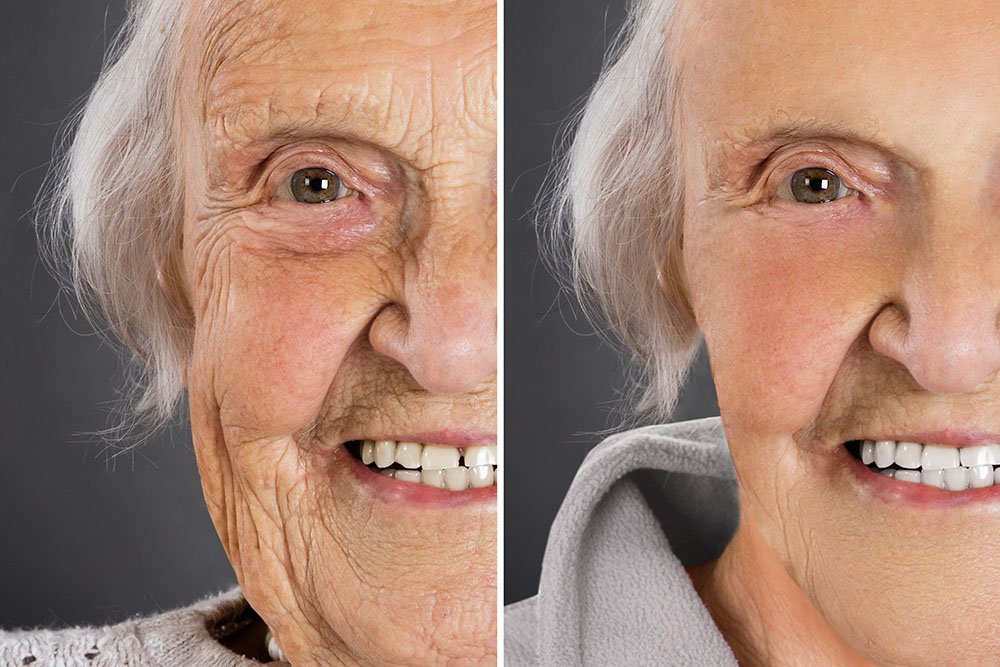
If you have a mild case of sagging skin on your face and jaw then this less invasive procedure may be right for you. The deep facial tissues are tightened through shorter incisions along the hairline above each ear. There are creases here naturally so the scarring will be virtually invisible over time.
The result is that the tissues around the jaw and cheeks are tightened and lifted producing a refined jawline and a much younger look. This procedure is often done as preventative care as it can delay the need for a full facelift. This procedure is often done with a neck lift and fat grafting around the face as part of an anti-aging package.
Surgery Time: 2-3 hours
Anesthesia: Local anesthesia with sedation (deep sleep) or general anesthesia
Hospitalization: Can leave the hospital after 2-3 hours
After Surgery Check-ups: 3-4
Recommended Minimum Time in Seoul: 10 days
Recovery Time to Normal Look: 3-4 weeks
Recovery Time to Full Setting: 6-12 months

If you have more than a mild case of sagging skin on your face then this more extensive procedure is required and the results will be more dramatic. The incisions are started near the temples and around the front of the ear. They are hidden by the natural folds leading to less visible scarring if any.
Excess skin is removed, the skin is smoothed out and deeper tissues are repositioned. The facial skin is pulled and tightened. This procedure drastically reduces saggy skin, wrinkles and makes you look years younger. This procedure is always done with a neck lift as it is necessary for balance and sometimes it is done with fat grafting for a younger look. A brow lift is often recommended as well as the facelift does not affect the areas above your eyes.
Surgery Time: 3-3.5 hours
Anesthesia: General Anesthesia
Hospitalization: 0-1 days
After Surgery Check-ups: 5
Recommended Minimum Time in Seoul: 14 days
Recovery Time to Normal Look: 4 weeks
Recovery Time to Full Setting: 6-12 months
If you have too much excess fat and skin under your chin it can create loose skin and abnormal contours. A neck lift can help improve this look and create a smoother and younger appearance.
This procedure is either done alone or in combination with a facelift and a brow lift. It is important to have the neck and face matching as much as possible for a balanced look. Korean necklift specialists use tiny incisions behind the ears and under the chin. Often liposuction is done to remove excess chin fat and the muscles are tightened. Excess skin is removed, pulled and tightened.
The result is smooth skin on your neck to match your face. This procedure is often done with a facelift and or browlift to rejuvenate your whole look.
Surgery Time: 2.5-3.5 hours
Anesthesia: General Anesthesia
Hospitalization: You can leave the clinic after 2-3 hours
After Surgery Check-ups: 3
Recommended Minimum Time in Seoul: 7 days
Recovery Time to Normal Look: 3 weeks
Recovery Time to Full Setting: 6-12 months
If you have an excess of skin (most likely due to aging) then it can be excised and removed. The most common areas to remove excess skin are under or above the eyes and around your ear to improve the neck or face for lifting procedures. These procedures are known as blepharoplasty.
The removal of the excess skin is accompanied by the skin, tissue and possible muscles in the area being tightened. The result is a smooth look with a decrease in wrinkles and sagging skin. Fat may be removed at the same time if there is an excess of fat and tissue.
Surgery Time: 30 mins- 1 hour
Anesthesia: Twilight anesthesia or Local anesthesia with sedation (deep sleep)
Hospitalization: You can leave the clinic after 2-3 hours
After Surgery Check-ups: 3
Recommended Minimum Time in Seoul: 7 days
Recovery Time to Normal Look: 3-4 weeks
Recovery Time to Full Setting: 6-12 months
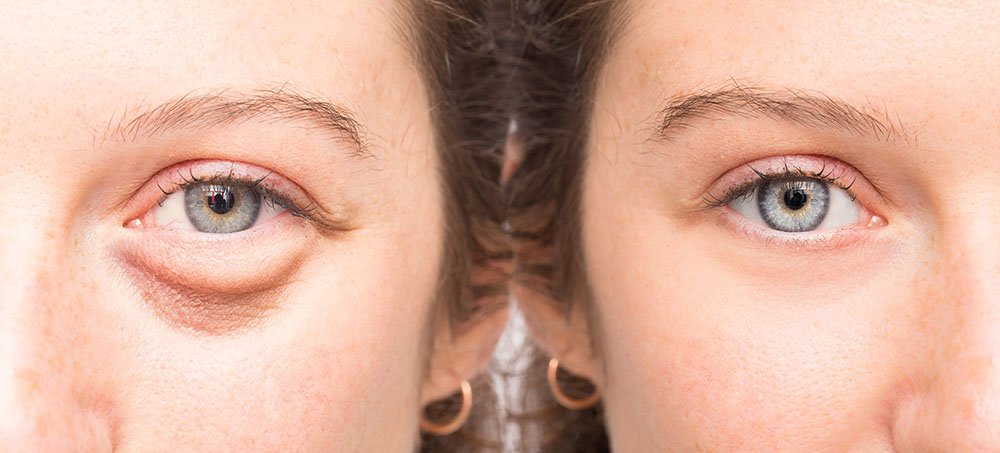
Liposuction removes excess fat from areas around your body. This excess fat is removed permanently but it doesn’t mean you can’t get fat in this area again. If you have an unhealthy lifestyle, you can get fat in that area but it will be much harder to gain fat there than before.
There are many kinds of liposuction but in general, it is either power-assisted liposuction or manual liposuction regardless of the name brand of equipment. Areas which are delicate like the double chin area are better suited to liposuction done manually as power-assisted liposuction is too strong for this delicate area. Larger areas are better suited for power-assisted liposuction. It is important to note that you will be required to wear a compression garment on the liposuctioned area for up to 2-4 weeks full time and after that while you sleep for 1-2 months for best results.
In the body, bruising and swelling is common and tends to spread downwards with gravity. In the chin area, swelling is common. Fat can also clump temporarily in certain areas and then smooth out over time for up to 6 months after surgery. Incision points by specialists are tiny and require only a minimal number. Scarring is virtually invisible.
Surgery Time: 30 mins- 1 hour
Anesthesia: Twilight anesthesia or Local anesthesia with sedation (deep sleep)
Hospitalization: You can leave the clinic after 2-3 hours
After Surgery Check-ups: 3
Recommended Minimum Time in Seoul: 10 days or 7 days if stitches are removed in your home country
Recovery Time to Normal Look: 3-6 weeks
Recovery Time to Full Setting: 6-12 months
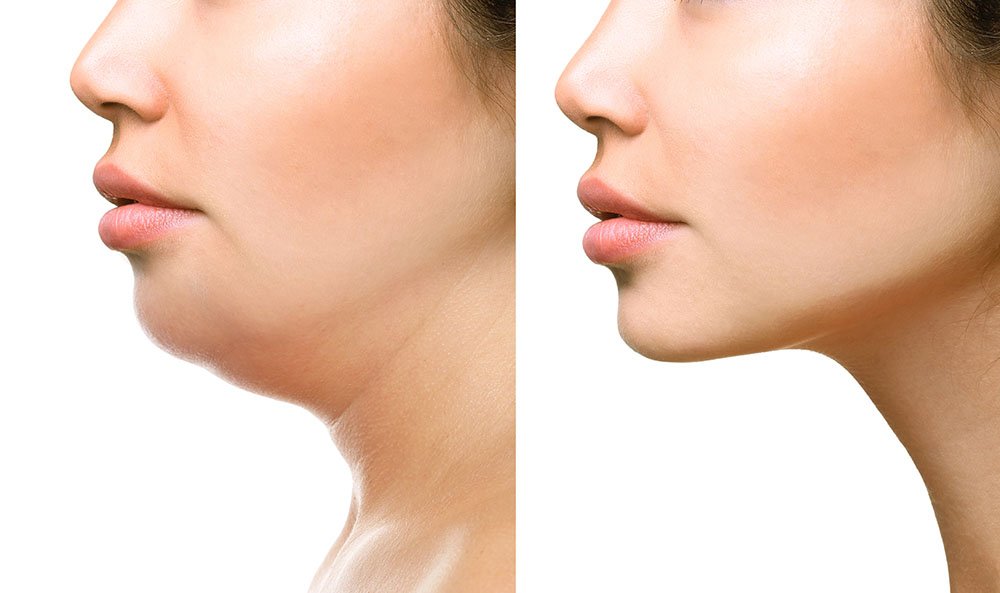
As we age, the fat tends to clump in some areas and decrease in others on the face. The most common places where people lose needed fats are in the cheeks, forehead, under the eyes and in the mouth lines.
This loss of fat can make us appear other and tired. Fat grafting can solve this aging issue by removing fat from another body part, processing it and grafting it into place. About 50% of the grafted fat survives.
Many clinics offer free or low-cost touch-ups where they store your fat for up to 2 months. If you are only coming once to Korea within 2 months then undergoing stem cell PRP therapy will increase the survival rate of the fat transfer. It is worth it for better long term results.
Surgery Time: 30 mins- 1 hour
Anesthesia: Twilight anesthesia or Local anesthesia with sedation (deep sleep)
Hospitalization: You can leave the clinic after 1-2 hours
After Surgery Check-ups: 3
Recommended Minimum Time in Seoul: 7 days or 5 days if stitches are removed in your home country
Recovery Time to Normal Look: 4-5 weeks
Recovery Time to Full Setting: 6-12 months
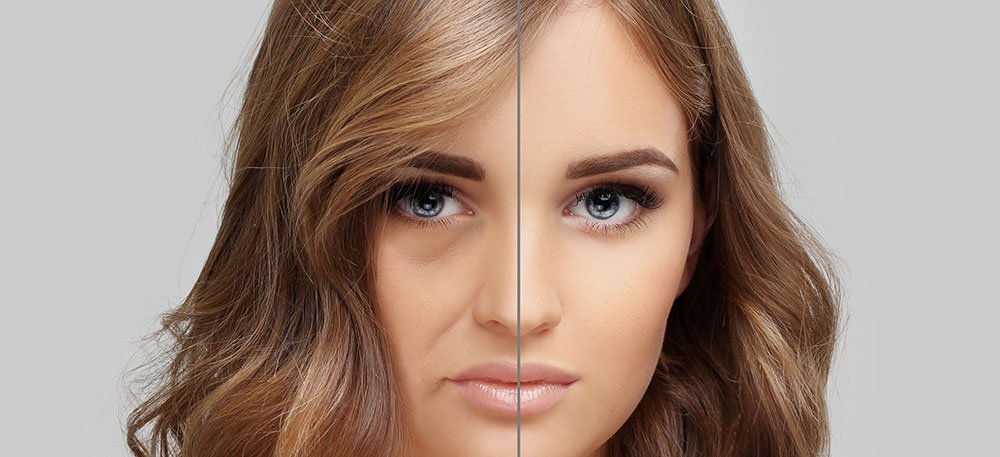
Anti-aging procedures come in all forms such as surgeries, injections and lasers. The goals of these procedures are to tighten droopy skin, improve thick and deep wrinkles, improve skin elasticity, smooth out pigmentation and improve saggy facial lines among other things. For example, someone who is 40 can look like she is just 30 after going through these procedures. The best and longest-lasting methods are surgical procedures such as lifts along with laser treatments. Botox (botulinum toxin A) is inserted into the muscle to blocks nerves in order to immobilize movement for a certain period of time. It is commonly used to improve forehead lines, the middle of forehead muscle, wrinkles are the eyes, the wide jaw look and to reduce the size of the calves. The effects last 3-6 months usually. Tip: Botox comes in powder form. It is then mixed with saline solution. The less powder is added, the more diluted the final Botox effect will be. Thus, be wary of super cheap Botox procedures because the mix of Botox powder and saline solution may be weak. Super cheap Botox often only lasts for 1-2 months and thus is more expensive in the long run. The correct mix of Botox powder and saline solution will yield a Botox effect of up to 6 months.
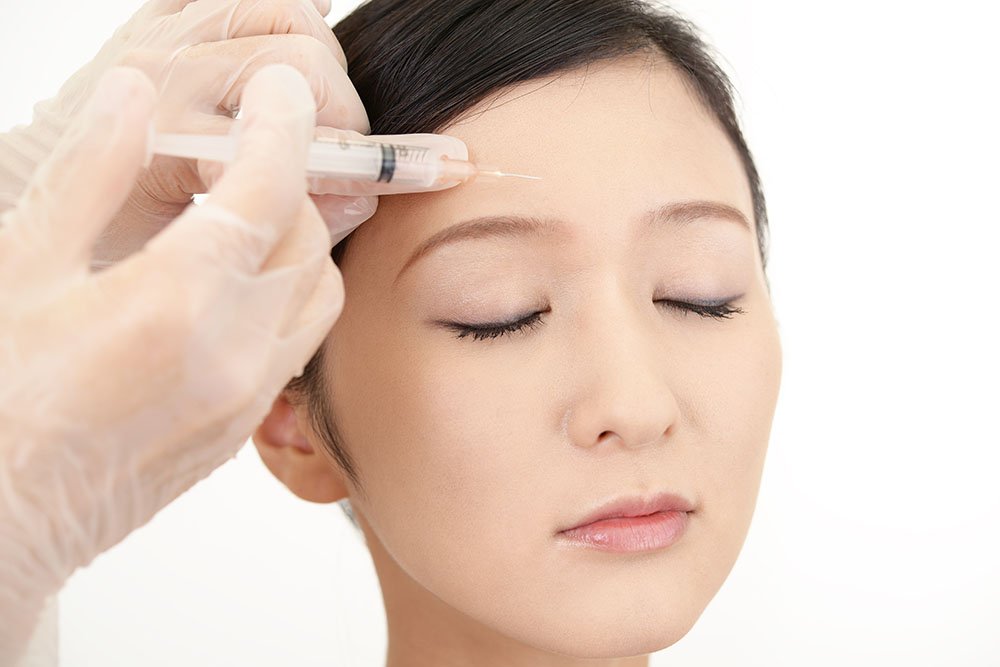
If you have depressions in your face then filler can be used to expand soft tissue. In general, fillers are used to replace natural substances in the skin (collagen, hyaluronic acid) lost due to aging and to improve wrinkles on the face. Filler is best used for dark circles under the eyes, to fill out the lips, to fill mouth lines, to reduce deep lines, to add more height to the chin and to add height to the nose. Filler can be used for other treatments such wrinkle reduction and scars but other options are better suited for this depending on the case. We don’t recommend using filler for large areas such as the forehead and the cheeks as filler tends to shift in those areas producing unsatisfactory results. We recommend the most people undergo temporary filler injections which last 6-12 months on average. These fillers can be dissolved with an anti-filler injection if the results are not to your liking. Semi-permanent fillers can last 2-10 years and in most cases can only be removed surgically. These fillers have a high rate of problems in certain areas over time so it is recommend to avoid them for most people. Surgery Time: 30 minutes Anesthesia: Topical anesthesia Hospitalization: You can leave the clinic immediately After Surgery Check-ups: 0 Recommended Minimum Time in Seoul: 1 day Recovery Time to Normal Look: 1-4 days Recovery Time to Full Setting: 1 week

If your facial skin has started to sag and is not as tight as before then non-surgical thread lifting is a great option. Dissolving threads will be placed under your skin around the upper part of your cheek running down towards the lower part of your cheek. The threads are pulled and tightened. The face is slightly lifted and tightened. This procedure produces the best results if a skin tightening laser (lifting laser also known a HIFU) as done with it. In addition, filler and Botox can be used for even better results. This kind of procedure typically lasts about 1 to 1.5 years and threads dissolve over time. Surgery Time: 30- 60 minutes Anesthesia: Topical anesthesia Hospitalization: You can leave the clinic immediately After Surgery Check-ups: 0 Recommended Minimum Time in Seoul: 1 day Recovery Time to Normal Look: 2-4 days Recovery Time to Full Setting: 1-2 week
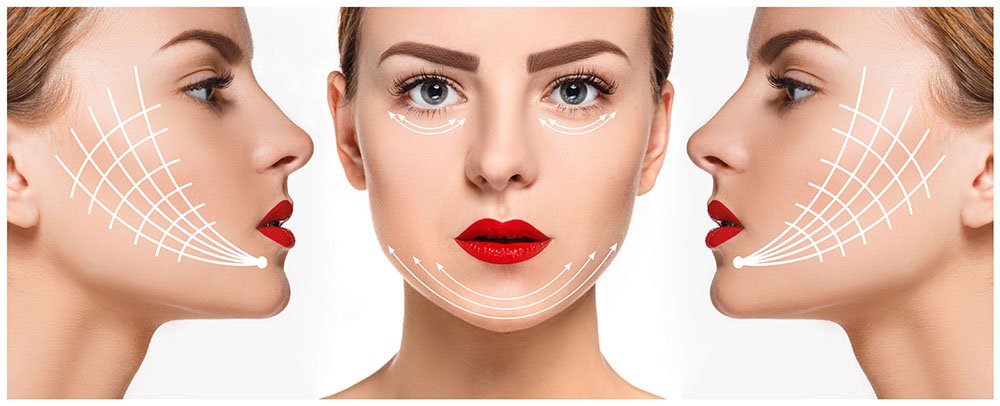
For patients with very mild sagging skin or those who are undergoing a non-surgical facelift, ultrasonic electrical impulse lasers can tighten your skin and make you feel years younger. HIFU, Ulthera, Doublo Series and Shurink Series lasers are the most common but the kind you need depends on your in-clinic exam. Ultrasonic electrical impulses are shot into different layers of your skin. The muscle, tissue and skin tighten producing the lifting effect while your body starts to increase its collagen production. A full course will do your neck and face including the forehead. A half course will do the area around your jaw. The biggest area where you will see and feel a difference is around the jaw line. Results are best for the first 2-3 months and last 6-12 months on average. This treatment does not compare with surgical lifting but it is a great option for those getting thread lifting or those who want a small but important improvement. Surgery Time: 30- 60 minutes Anesthesia: Topical anesthesia Hospitalization: You can leave the clinic immediately After Surgery Check-ups: 0 Recommended Minimum Time in Seoul: 1 day Recovery Time to Normal Look: 2-4 days Recovery Time to Full Setting: 1-2 week
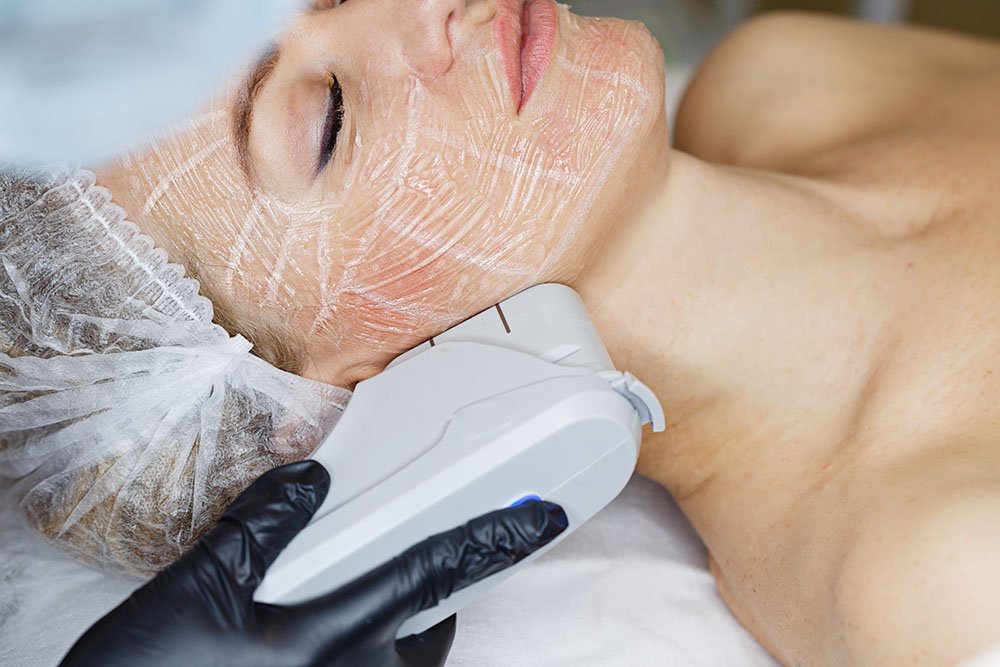
Stem cell therapy is only done at specialized clinics and provides a great anti-aging effect for both cosmetic beauty and for your health. Stem cell skin therapy or derivatives of stem cell skin therapy can be done in one day when applied topically. For extensive stem cell therapy done through injections, you will need to stay in Korea for 1 week, 2 week, 1 month, or 3 month treatments. You don’t need to be in Korea all the time as it just takes one day to provide the treatment so you can leave the country and return when you are scheduled for your next treatment. This kind of stem cell therapy is expensive but it can reduce physical problems and turn back the hands of time. Surgery Time: 30- 60 minutes Anesthesia: Topical anesthesia Hospitalization: You can leave the clinic immediately After Surgery Check-ups: 0 Recommended Minimum Time in Seoul: 1 day Recovery Time to Normal Look: 2-4 days Recovery Time to Full Setting: 1-2 week

Body Shaping Plastic Surgery Procedures In Korea
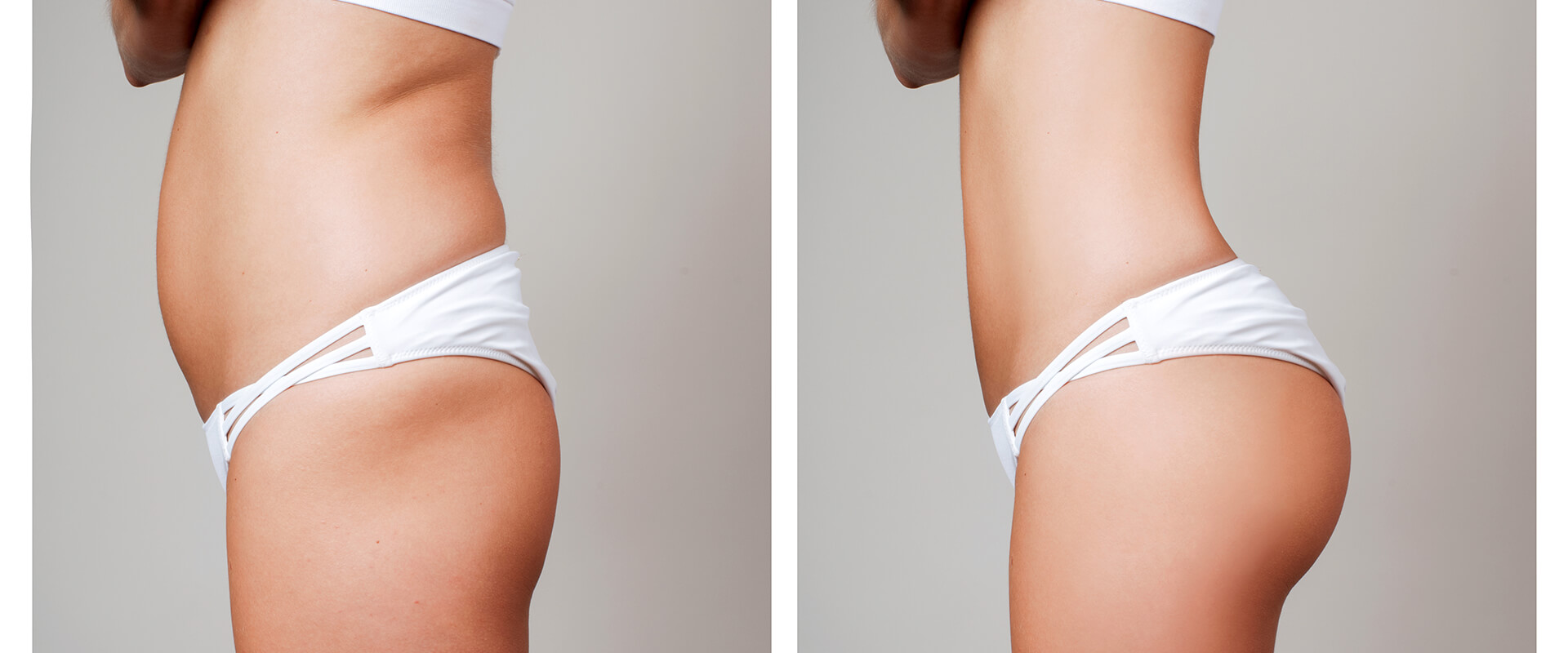
If you have excess fat, it can be removed by making a tiny incision and removing the fat via a cannula. This procedure is very safe and can remove hard to lose fat on the chin, arms, back, flanks, tummy, thighs and other areas. The most common technique to remove fat is called tumescent liposuction where a sterile solution is injected into the target area which makes it easier to remove the fat with little pain and blood loss. For some locations, the surgeon will perform liposuction by hand. This is especially true for delicate areas such as the chin area. For larger areas, machine-assisted liposuction can be used consisting of laser-assisted, ultrasound-assisted or similar types of equipment. Seoul Guide Medical has seen thousands of liposuction cases and there is no significant difference in regards to the equipment used in terms of results. What is more important is the skill of the doctor when it comes to liposuction. The removed fat will not come back as those fat cells are gone forever. However, if you lead an unhealthy life style you can still gain fat in the liposuctioned areas. It is best to link of liposuction as a chance for a fresh start. What you do after that, is up to you. Surgery Time: 2-3 hours Anesthesia: Local anesthesia with sedation (deep sleep) Hospitalization: Can leave the hospital after 2-3 hours After Surgery Check-ups: 3-4 Recommended Minimum Time in Seoul: 10 days Recovery Time to Normal Look: 2 months Recovery Time to Full Setting: 6-12 months
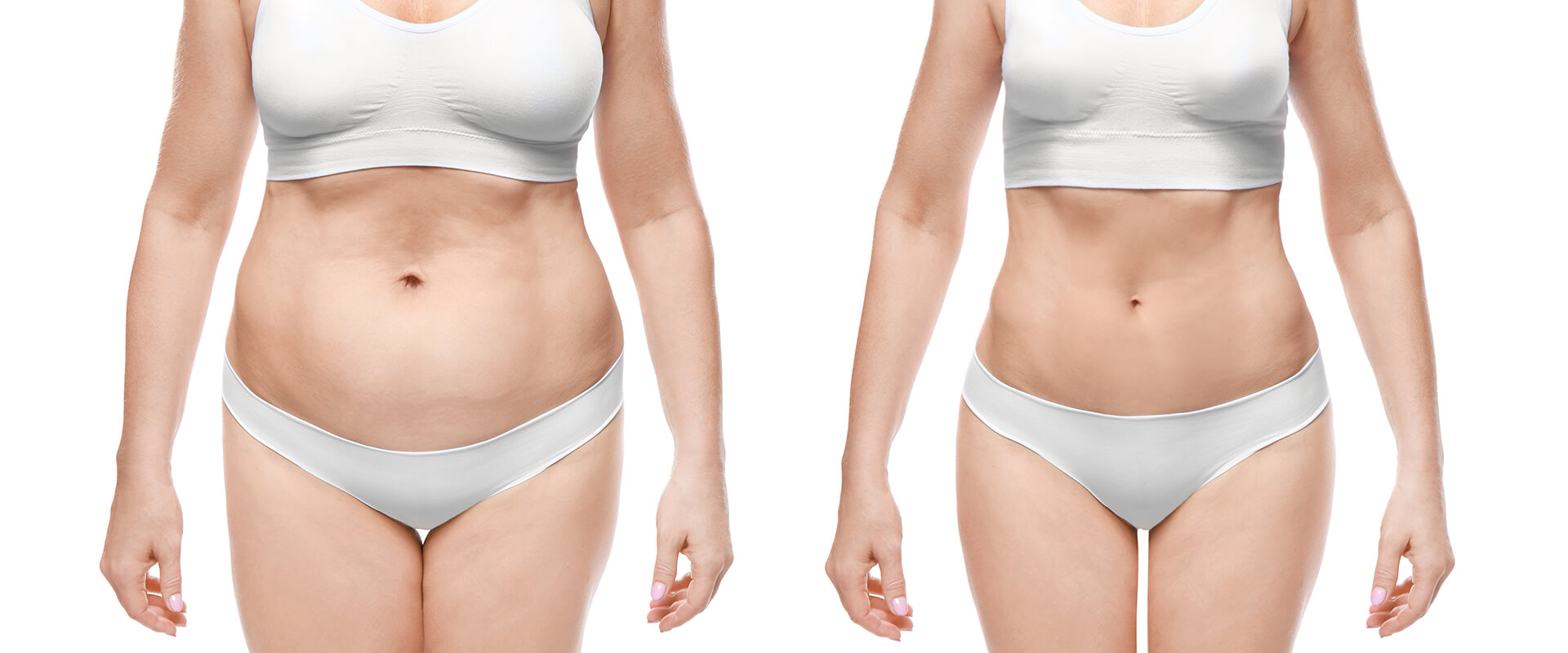
If you have excess fat in the stomach area liposuction may not be enough. With large weight loss or the removal of large amounts of fat, excess skin will form. This often happens after giving birth or those who have lost large sudden amounts of weight. To remove the excess skin and fat and abdominoplasty (tummy tuck) can be performed. It also restores weakened or separated muscles making a better abdominal profile which is firmer and smoother. This procedure can really improve your quality of life physically as it will strengthen your core. There will be a scar and this is unavoidable. However, top Korea surgeons are experts are minimizing scars. The incision location depends on your case. This procedure requires someone to help you afterward and Seoul Guide Medical will provide you with a dedicated helper to make sure you get the help you need after surgery. Surgery Time: 2-3 hours Anesthesia: Local anesthesia with sedation (deep sleep) or General Anesthesia Hospitalization: Can leave the hospital after 3 hours After Surgery Check-ups: 3-4 Recommended Minimum Time in Seoul: 10 days Recovery Time to Normal Look: 2 months Recovery Time to Full Setting: 6-12 months
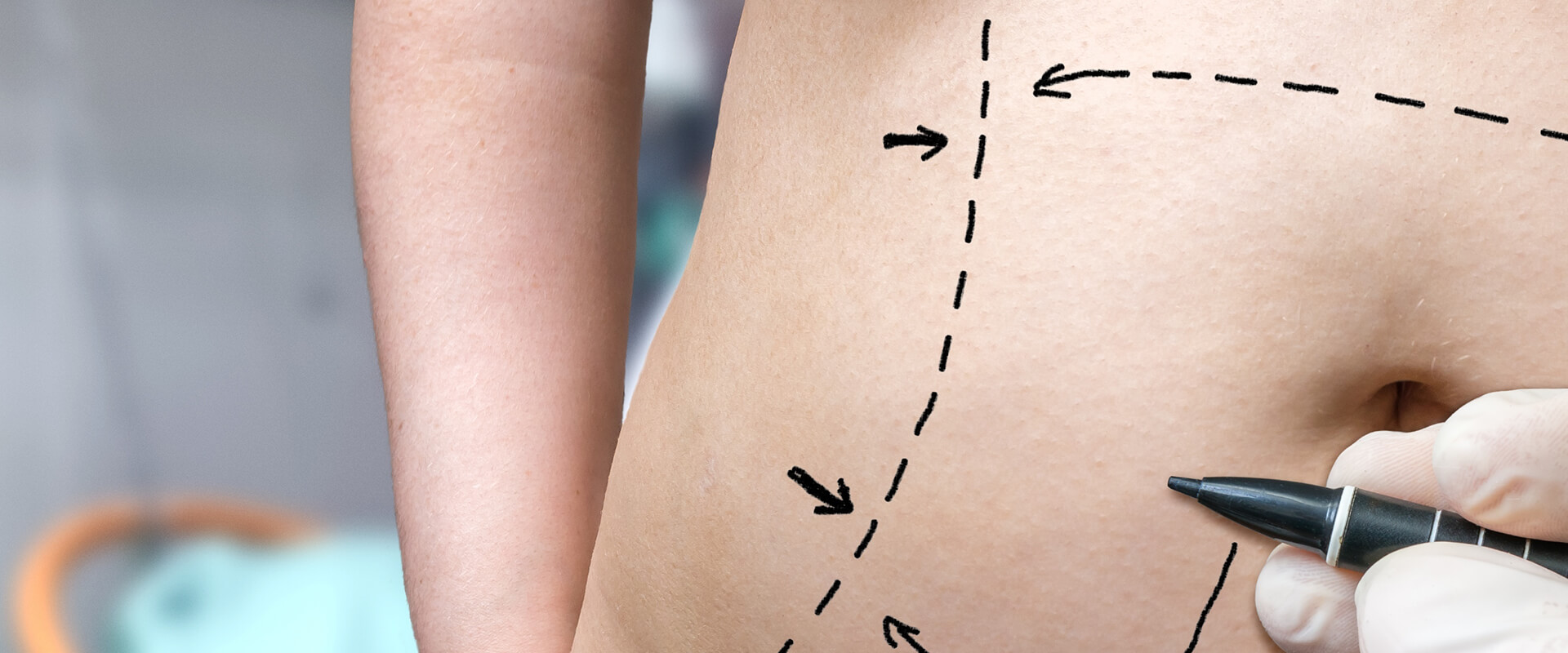
For most women and an increasingly large percentage of men, long and thin calves are considered ideal. It makes you look more elegant, taller and more graceful. Calf shaping and reduction procedures were first invented in Korea and it is one of the most popular procedures here. Many women find this procedure functionally useful as well as large calves block you from fitting into fashionable knee high boots. For most people, an ideal calf circumference is around 32-34cm but it varies from person to person depending on your calf anatomy and your gastrocnemius muscles. If you have oversized calves and wish to reduce them, there are several methods. Your calf can be reduced by removing excess fat via liposuction but most of the bulk of the calf is made of muscle. Burning off the muscle to shape the calf is possible but it is painful and there are some complications. A safer method is by blocking the nerve(s) which feed the muscle(s). This will cause the calf to atrophy a bit to get the desired slender shape over the next few months. The incision is small and hidden away so any possible scarring is not very visible. If you are a professional athlete then surgical options are not recommended as it can lead to some loss of power in your calves. However, for most people with normal exercise routines they will see no difference in power loss. This is done through radiofrequency nerve ablation. The kind of procedure you will need depends on your case. If you want a temporary procedure then Botox is another option but the results are limited and last for 3-6 months only. Surgery Time: 1-2 hours Anesthesia: Local anesthesia with sedation (deep sleep) Hospitalization: Can leave the hospital after 1-2 hours After Surgery Check-ups: 2-3 Recommended Minimum Time in Seoul: 5-7 days Recovery Time to Normal Look: 1-2 weeks Recovery Time to Full Setting: 6-12 months
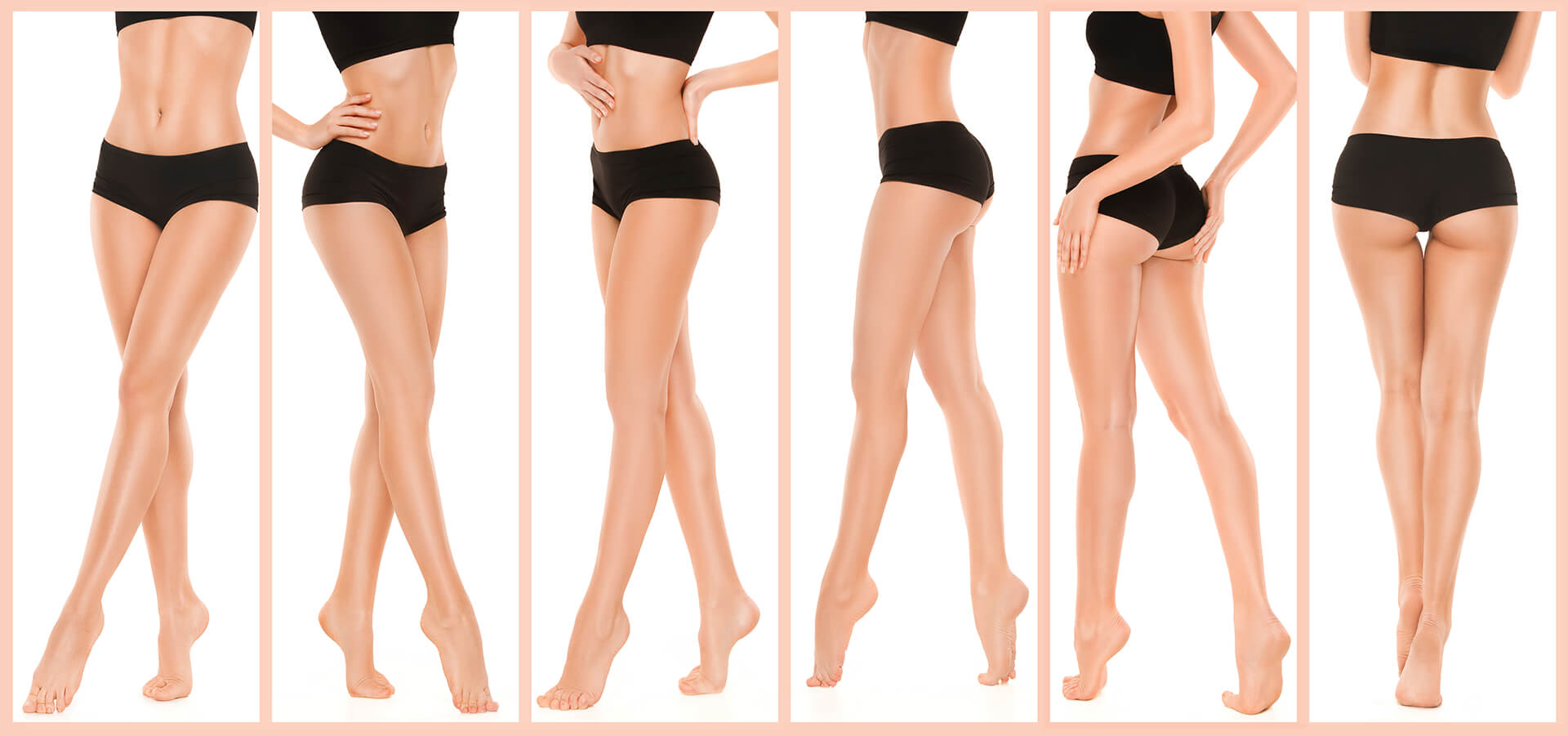
If you have an aversion to surgical procedures then there are a few non-surgical body contouring options. Non-surgical body shaping procedures include fat destroying treatments through machines and fat dissolving injections. Older fat destroying machines would freeze your fat away but they were painful with long recovery times. Newer equipment such as the Ultrafocus Lux System is pain-free with the better results. Fat dissolving injections place a solution in the target area and dissolve portions of the fat in that area. Some swelling occurs which can take 1-2 weeks to dissipate completely. The injections are a bit painful as they are injections after all. This injections are often done on the double chin area and in areas with bulges of fat. Often the machine and injection system are utilized together for best results. Both methods involve the destruction of fat cells whereby they are turned into substances which are processed out through the body so drinking a lot of water after the procedure is recommended. These procedures do show results but best results are seen after 3-5 sessions. In addition, no non-surgical procedure for body shaping can compare to surgical methods such as liposuction. If you want the best possible improvement then you should take the surgical route. If that is not possible then the non-surgical approach should be considered. Procedure Time: 30-60 minutes Anesthesia: topical anesthesia Hospitalization: Can leave the hospital after immediately After Surgery Check-ups: 0 Recommended Minimum Time in Seoul: 1 day Recovery Time to Normal Look: 1-2 weeks

Breast Surgery In Korea

What size should I get? The size of the breast implants is determined by your skin thickness, weight, body shape, needs and wants. For example, in many cases, very thin patients can get 300cc (cubic centimeters) implants or more but it will not look natural on their body. If you want a natural look it is important to follow the doctor’s advice. To help you imagine how many cc are best for you to try to think that 150-200cc is roughly equal to 1 to 1.5 cup sizes but this varies depending on breast tissue and chest width. Most patients have happier long term results if they follow the doctor’s advice and go with the size that best suits their body type. How much projection should I go for? Implants come in 4 types of projection: low profile, moderate profile, high profile, and extra high profile. Low profile implants have a small forward projection and are best suited for those with a wider frame looking for balance. The moderate profile is the most realistic looking kind of implant and are best suited for those who want a wider chest look. High profile implants have a strong projection and are best suited for those who don’t want to appear to have a wide chest. Extra high profile implants have the greatest projection and are best suited for those who want a smaller chest diameter but a more noticeable depth. Round or Tear Drop? We can conclusively say that the shape of the implant (round or teardrop) depends totally on your body and what you want. Some patients will benefit more from round implants which have more volume in the top half of the breast while others will see better results with a more anatomical shape create with the tear drop implants. Round implants are still the leading kind of implant. If you are looking for more volume in the top portion of your chest and your body is suited for it, then round implants are a better choice. Please note that round implants tend to look more artificial when looking at the naked body than teardrop implants but they provide a fuller breast look. Teardrop implants have more volume at the bottom similar to real breasts. These implants are not as filled out at the top as found implants but they provide greater projection and look more natural when looking at the naked body. Under the muscle, partially under the muscle or above the muscle? The placement of the breast implants is best left to the advice of your specialist surgeon. Placing it under the muscle (submuscular) allows a great amount of breast tissue to cover the implants leading to softer breast and less risk of ripples. It has longer recovery time and is more painful. If you currently have saggy breasts then a breast lift is recommended as well with this placement. Those who exercise heavily with weights are not good candidates for this placement. Partially under the muscle (dual plane) is a very skilled procedure where the implants are placed only partly under the muscle and it reduces the need of a breast lift. Over the muscle placements (subglandular) are best suited for those who already have the necessary amount of breast tissue which will cover the implant. It has a shorter recover time and is often done without the need of a breast lift. At Seoul Guide Medical we strongly advice you to listen to your surgeon. Go with the placement that the surgeon recommends for better long term results. Where will the incision be made? There are 3 main incision methods: transaxillary, inframammary and periareolar. The transaxillary method uses the armpit area for the incision location. The folds and wrinkles in the armpits hide scars very well. However, larger breast implants cannot be placed effectively using this method. This method is more suited for those looking for more natural breast size. The inframammary method using the breast fold and the incision is made under the breast fold. An expert will minimize scarring but you can expect some scarring to be visible. This implant incision area is best suited for those who want to have large or extra large implants and are comfortable with a visible scar. The periareolar method inserts the implant by making an incision around the nipple. Because of the way the nipple area is formed, scarring is hard to notice. This procedure may affect breastfeed ability so if breastfeed is important for you, please avoid this method. There is one more method which is not commonly utilized, the navel insertion. Implants are placed through the belly button however the success rate of these implants is lower and more complications arise from it. It is best to avoid this method if possible. Surgery Time: 2-3 hours Anesthesia: General anesthesia Hospitalization: 0-1 day After Surgery Check-ups: 3-4 Recommended Minimum Time in Seoul: 14 days Recovery Time to Normal Look: 2 months Recovery Time to Full Setting: 6-12 months Hemo Vac Removal: 3 days Fixable Bra: You should wear it for at least 14 days after surgery

If you are looking for less drastic and more temporary increases in bust size and shape then fat grafting is an option. For longer lasting results, this procedure is best done over 2-3 sessions and a single session may not procedure the desired results. Fat is liposuctioned from the tummy, thighs, buttocks or the flanks, processed and grafting to the breasts to correct asymmetry and increase the size. The best candidates for fat grafting to the breasts are women who have sufficient amounts of fat in their body for this procedure and understand that a single fat transfer procedure may yield only temporary results (results improve over 2-3 transfers). Fat transfer to the breast yields a survival rate of 50-80% but again we must stress that 2-3 sessions are needed for best results. You can expect an increase of cup size up to 1 full bra cup size. This procedure is great yields the best results on women with smaller frames as a 1 cup bra size increase will appear bigger than a woman with a larger frame. If you want a larger increase in volume then implants will procedure better results. Surgery Time: 4-6 hours Anesthesia: Local anesthesia (deep sleep) or General anesthesia Hospitalization: You can leave after 2-3 hours After Surgery Check-ups: 3-4 Recommended Minimum Time in Seoul: 10 days Recovery Time to Normal Look: 2 months Recovery Time to Full Setting: 6-12 months Fixable Bra: You should wear it for at least 14 days after surgery
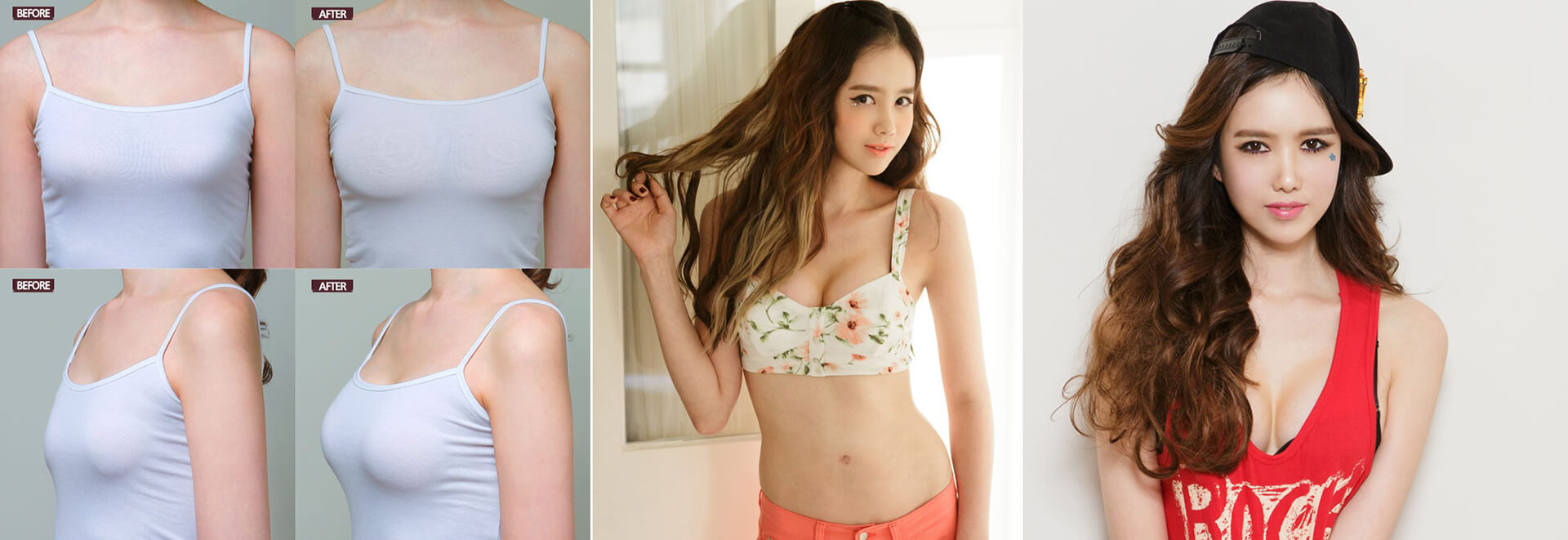
As we age, breast tissue and skin lose elasticity causing the breasts to sag downwards. This problem can be corrected via breast lifting. It is common for women who have gone through pregnancy, have gone through breast feeding, have lost sudden weight or have aged in this manner. There are 3 stages of breast drooping. Stage A mastoptosis is when the nipple is drooped below the inframammary fold by less than 1cm. Stage B mastoptosis is when the nipple is drooped below the inframammary fold by 1-3cm. Stage C mastoptosis is when the nipple is drooped below the inframammary fold by 3cms or more or is pointing downwards. In some cases, you will benefit more by combining a breast lift with breast augmentation via implants. This will give the best and most long lasting results. Surgery Time: 3-5 hours Anesthesia: or General anesthesia Hospitalization: 0-1 day After Surgery Check-ups: 3-4 Recommended Minimum Time in Seoul: 14 days Recovery Time to Normal Look: 2 months Recovery Time to Full Setting: 6-12 months Fixable Bra: You should wear it for at least 14 days after surgery
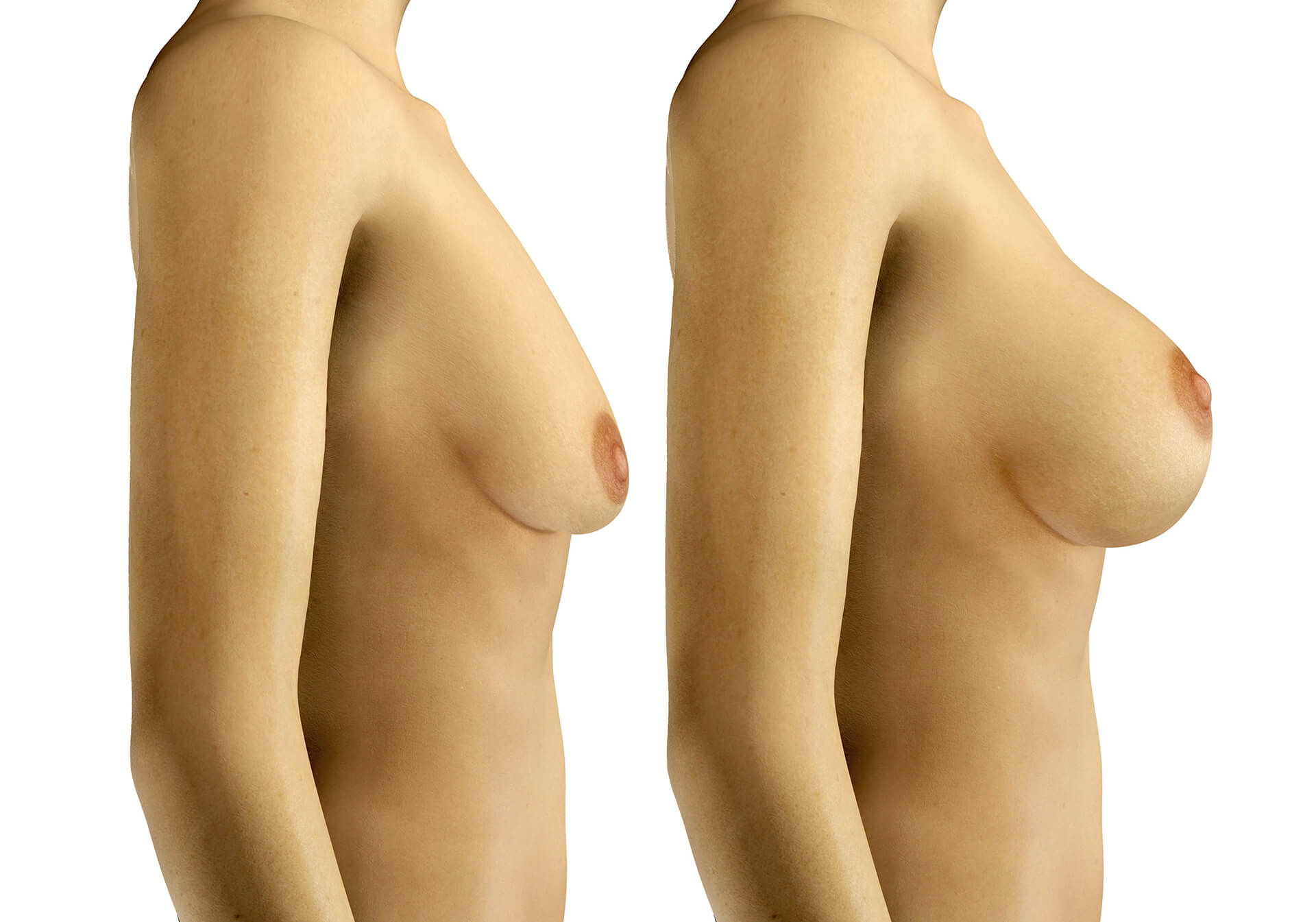
If you have breasts which are too big and or are causing you pain then a breast reduction may be right for you. Often women with over 400cc of breast tissue experience physical pain, neck and back problems due to the weight of their chest. The breasts can sag downwards causing issues when a bra is not worn. There are 3 main methods for breast reduction: vertical incision, areola incision and inferior pedicle incision. The vertical incision is best for women who wish to retain breast feeding potential. The incision is made in a vertical line running down from the bottom center of the nipple. There will be slight scarring visible afterwards. The areola incision is best for those who do not want visible scarring and who’s breasts are not too oversized. This method retains breast feeding potential. The incision is made around the areola so visible scarring is minimal. The inferior pedicle technique is best for extremely large and saggy breasts as it incises around the areola and vertically down to the breast fold from the center of the nipple. Scarring is the most visible here but for women with very large and very saggy breasts, this is the best option. Surgery Time: 3-5 hours Anesthesia: or General anesthesia Hospitalization: 0-1 day After Surgery Check-ups: 3-4 Recommended Minimum Time in Seoul: 14 days Recovery Time to Normal Look: 2 months Hemo Vac Removal: 3 days after

If your nipples and or areola (the dark area around the nipples) are too large then internal nipple tissue and areola tissue can be removed to create a more balanced look. Many women and men are self-conscious due to their excess nipple and or areola size. Having this simple procedure can really help improve your look by making the area balanced with the rest of your chest and body. Surgery Time: 30-60 minutes Anesthesia: Local anesthesia with sedation (deep sleep) or General anesthesia Hospitalization: Can leave the clinic after 2 hours After Surgery Check-ups: 3-4 Recommended Minimum Time in Seoul: 10-14 days Recovery Time to Normal Look: 2 months
